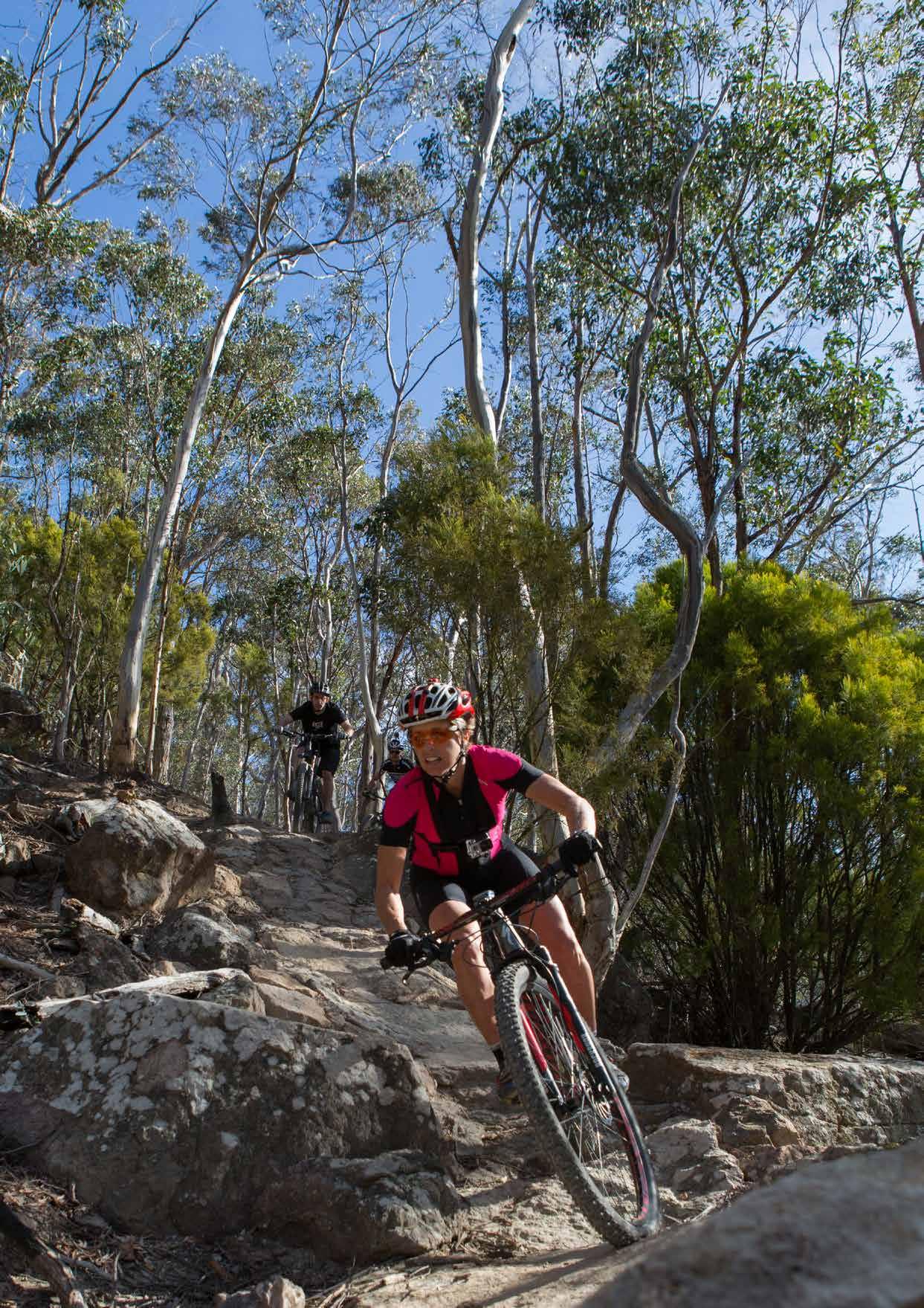
A COMMUNITY VISION FOR OUR ISLAND CAPITAL

Acknowledgments



Acknowledgments
Hobart breathes.
Connections between nature, history, culture, businesses and each other are the heart of our city.
We are brave and caring.
We resist mediocrity and sameness. As we grow, we remember what makes this place special. We walk in the fresh air between all the best things in life.
This document is a community vision for our city: Hobart, Tasmania.
Over 1100 contributions from community members and stakeholders from across greater Hobart went into creating it. The first draft was written by the Community Panel, a group of 46 Hobart community members and business people from a range of backgrounds and suburbs in greater Hobart, who then collaborated with the City of Hobart to create this vision, Hobart: A community vision for our island capital.
The vision is future-focused. It describes what people love and value about Hobart and how they want it to evolve.
Its purpose is to guide all of the City of Hobart’s work, so that Council decisions help create the Hobart that our communities want, for current and future generations.
The vision is not a concrete plan or set of actions. It does not talk about specific policies, budgets or projects. Instead, it articulates the kind of future Hobart communities would like to see, as expressed through vision community engagement.
The City of Hobart then responds to these community values and aspirations by setting out specific strategies, plans, actions and measurements that outline exactly how Council will help communities build their desired future. All Council strategies and plans, beginning from the endorsement of this document, are designed to implement and deliver on the intentions written into the vision.
In particular, the vision guides and directs the City of Hobart’s strategic plan, which outlines Council’s priority actions from across the organisation over 10 years. Ten-year strategic plans are required of all Tasmanian councils under the Local Government Act 1993. Having a community vision to guide strategic planning ensures that Council’s work is relevant to what the people of Hobart want for their city.
The City of Hobart does not have direct responsibility or influence over all aspects of Hobart life and identity; many aspects of the vision talk about topics, such as creative arts and disaster preparedness, that involve diverse people and industries. Still, local government has a range of roles that provide opportunities for it to support Hobart communities in working toward their vision for the future. These roles are reflected in the strategic and other plans, where the vision is put into action.
The vision is for the City of Hobart Local Government Area but it takes a capital city perspective. It acknowledges that many people beyond those living within Hobart local government boundaries participate in and have a stake in the life of the city. Many important topics, such as transport and housing, also cross those boundaries. This vision provides an opportunity for anyone reading it to learn about what members of Hobart’s many communities aspire to for the future of their city.
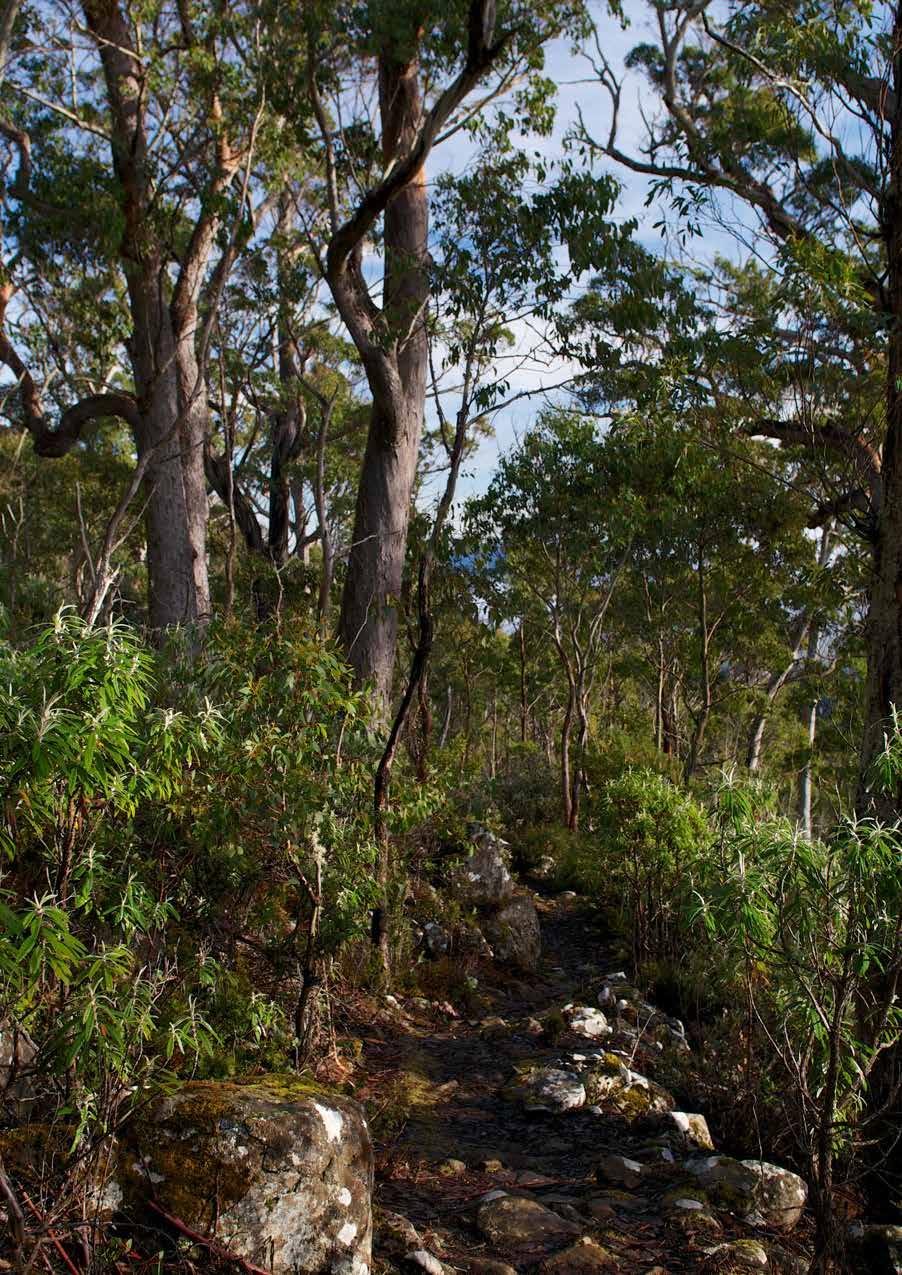
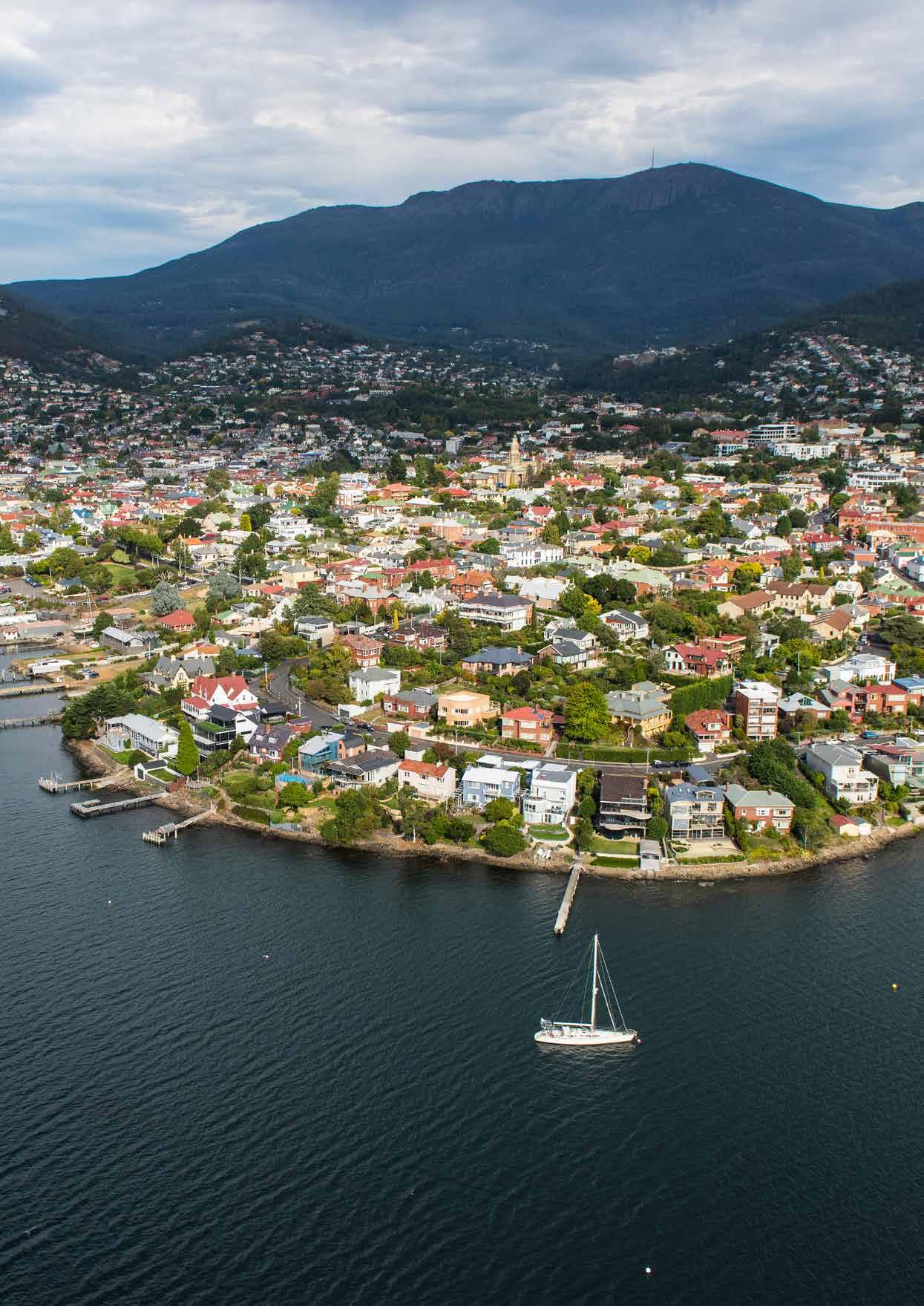
Picture, for a moment, your favourite place. Is it where you grew up, or a place you visit on special occasions? What does it feel like to be there? What can you smell? What can you hear? What is it about your special place that makes you long to go back or visit often? The memories you have of this place are as vivid and real as if you were there yesterday.
This is how palawa - Tasmanian Aboriginal people - feel about their homelands. We call this feeling milaythina.
palawa people have cared for the Country around Hobart for more than 2000 generations, through at least two ice ages, and for more than 50,000 years. It was here that the nuenone, melukurdee, lyluquonne and mouherneena hunted for food.
Our ancestors valued the importance of community; everyone had a role to play.
Our ancestors practised what is now the oldest living culture on Earth.
Our ancestors’ economies were highly sophisticated respect and honour systems.
Our ancestors knew the seasons that would bring new growth, or new life, and the seasons that told them when to move to a different site, to enable resources to replenish. Our ancestors knew the plants that provided medicines for healing. Our ancestors lived with the land.
Our ancestors continually burnt Country to allow new growth, to cleanse the Country, to maintain access to traditional roads and hunting grounds.
Our ancestors planned for generations into the future. Their lifestyle was sustainable.
Our ancestors recognised the impressive beauty of their Country and never took it for granted.
Our ancestors respected everything and everyone around them. Everything was equal.
Our connection to this Country is a feeling that is hard to describe but it is a feeling that we all can relate to.
Today’s Aboriginal community continues to uphold the values and legacy of our forebears but we can’t do this alone; we want to walk this journey together.
Trish Hodge
Tasmanian Aboriginal Vision Project Community Panel member
The City of Hobart acknowledges the palawa people as the traditional and ongoing Custodians of lutruwita (Tasmania). The City of Hobart pays its respects to the Elders past, present and emerging, as we work towards the community’s vision for future Hobart.
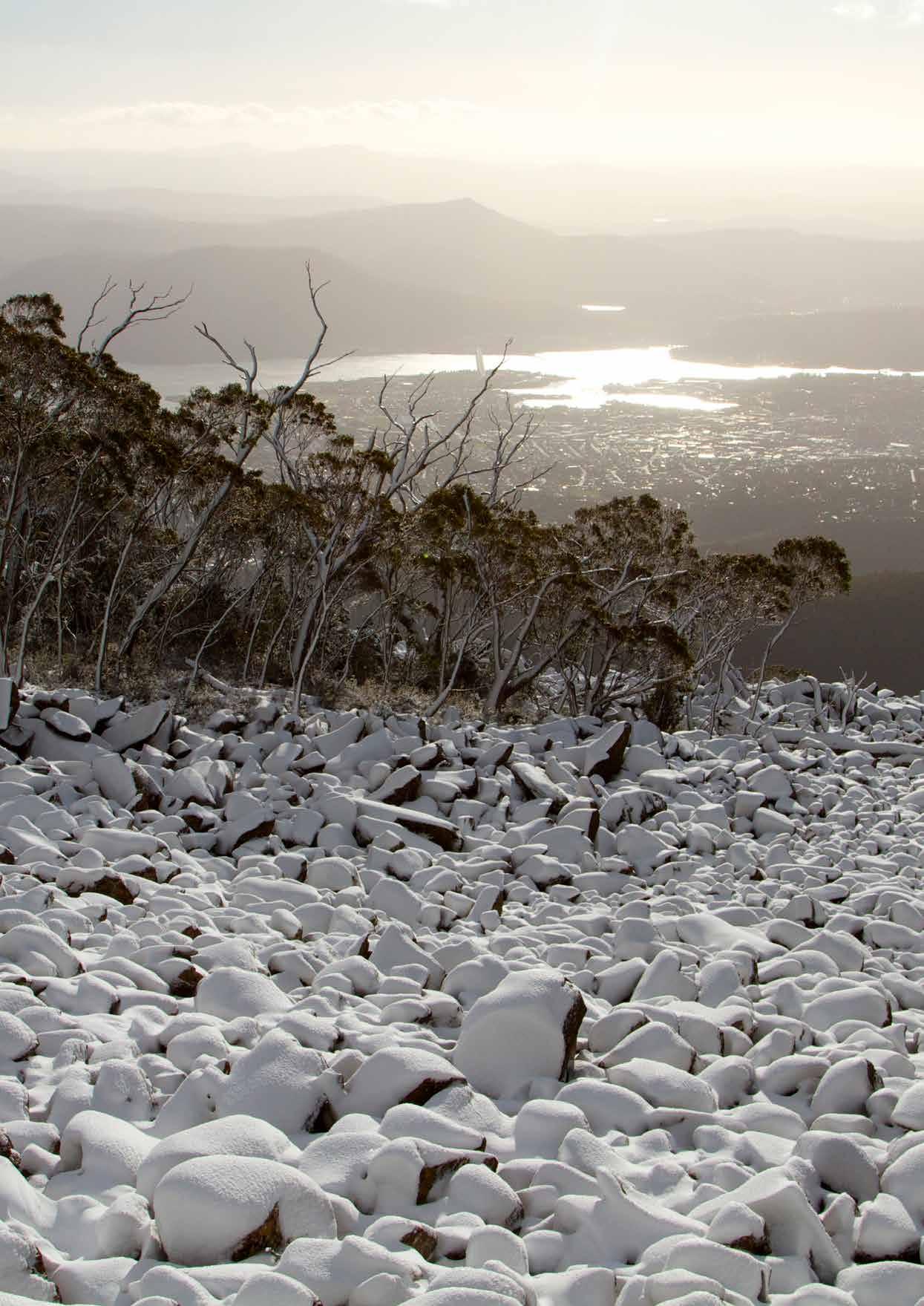
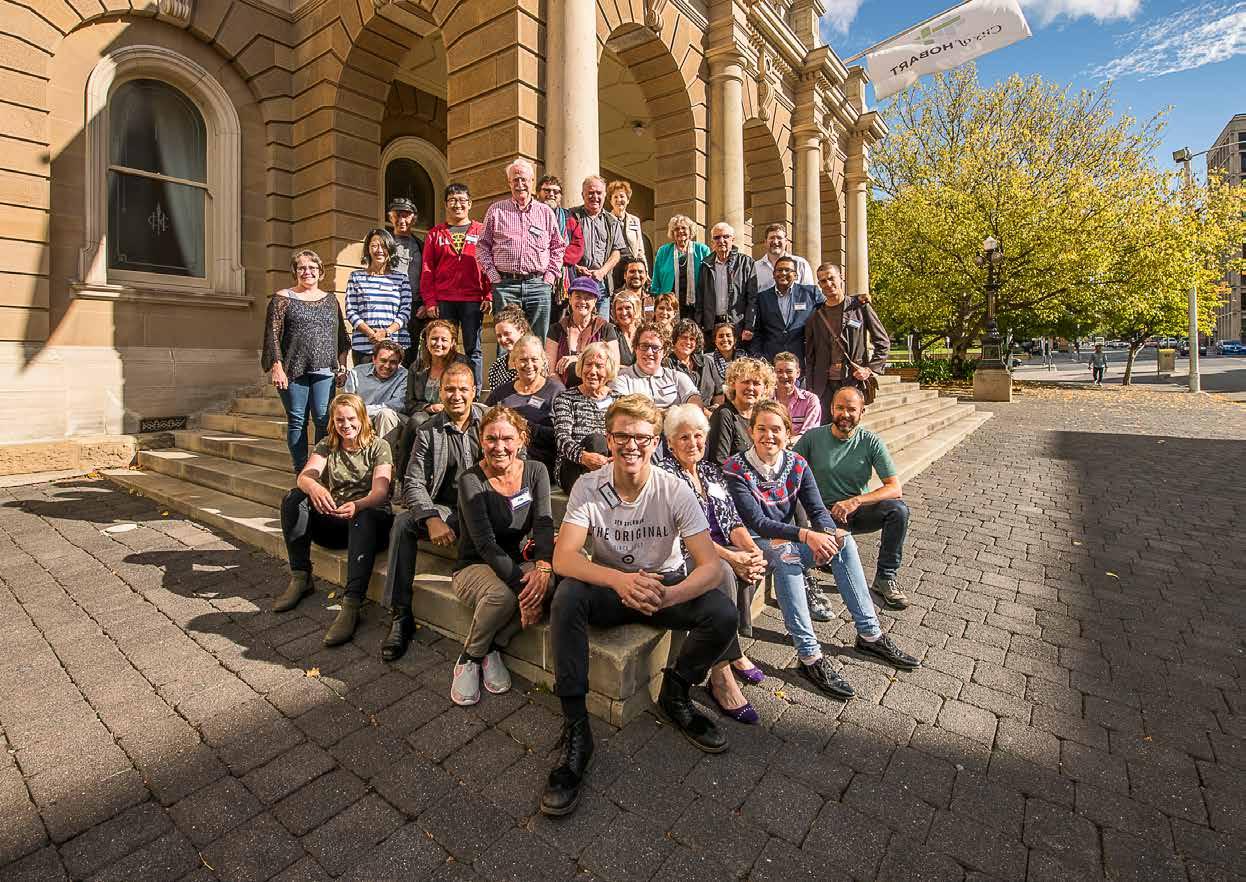
The panellists acknowledge the strong leadership of the City of Hobart in establishing this process and in making the firm commitment to genuinely listen to the Community of Greater Hobart and to wholeheartedly respect and nurture Our Hobart Identity.
We have not taken this vision process for granted or wasted this unique opportunity.
We are 46 community members and businesspeople who came together to help draft Hobart’s vision. We worked with each other and listened to the wider community to understand our place and its future. We collaborated, we engaged with experts, and many had sleepless nights in determining what is most important about Hobart and our preferred direction.
As we passionately challenged each other and ourselves it was clear that there is something about this place that we all felt and knew was true.
We all live, work and play in the midst of our mountain, our river and the land around us, which constantly remind us of where we are and provide us with comfort, wonder and joy. The Hobart community has strong connections with each other and we relish the familiarity of our interactions and revel in our unique lifestyle and freedoms.
There is a feeling of pride in where we are: an identity, unique and lasting connections with people and place, a shared happiness, comfort and contentment.
This is tempered by a healthy level of trepidation. We are on a precipice.

We are happy to grow and share our home but don’t want to lose what we love about this place.
Throughout this process, a feeling was everpresent—a meaning and a purpose that we at times struggled to fully articulate because it is more than words.
Hobart is now big enough to change but still small enough to care.
The rest of the world has now discovered what those who live here always knew and now more fully appreciate. The stakes are higher than we can remember and the spotlight is on. As a community, with the courage and support of our council, we aim to be brave enough to create a plan and follow it through. A plan for a preferred future, not one driven by greed, or
left to chance. A plan that aims to inform and inspire those who don’t yet understand.
There is an overwhelming excitement for our future and we are depending on each other and our leaders to maintain the courage to govern, support and deliver our shared vision.
Throughout this process and beyond, the people of Hobart will continue to take interest in the ongoing implementation of this vision, the successes in delivering on our preferred outcomes, the protection of our unique and highly-valued lifestyle, and the steps taken to maintain Our Hobart Identity.
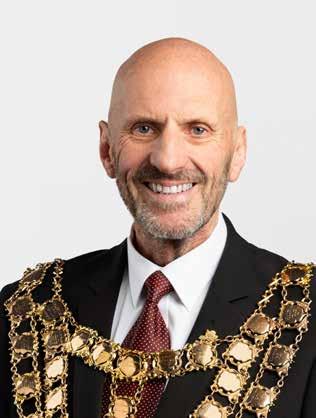
As Lord Mayor of the City of Hobart, I am delighted to introduce this document – Hobart: A community vision for our island capital.
Over the past six months, the City of Hobart has heard thousands of examples of what community members and stakeholders love about Hobart. We learned about what people value and what they aspire to for our island capital, and what we stand to lose if we get it wrong.
The commitment and connection that Hobartians feel to this city and this community is strong.
The vision is created from a collaboration between Hobart communities and stakeholders, the Vision Project Community Panel and the City of Hobart. It is the result of more than 1100 contributions about the future people want to see. It is about Hobart, the place, and Hobart, the people, whose lives, work, stories and aspirations define this city. This vision is a community statement about identity as much as ambition.
This document aims to both encapsulate those ideas and acknowledge that each person experiences the city in different ways. It contains stories about the wonders of
Hobart’s geography, the importance of our heritage, the connectedness of our communities, the human scale of our cityscape, the vibrancy and diversity of our cultures, the resourcefulness of our spirit, and our deep civic pride.
It is the Council’s job to respond to Hobart communities’ aspirations for the city, and this vision will guide the City of Hobart’s work. The collective wisdom and vision of Hobart’s people will both create and lead us into the future. The Council has a responsibility to enhance what Hobart communities value and ensure everyone has an opportunity to access and participate in their version of the ‘Hobart lifestyle’.
Hobart is at one of the most important moments in its history. At a time of incredible change, the decisions that we make today, as community members, stakeholders and Council, will determine whether we maintain our identity as a city far from ordinary.
Hobart community members from across the city said again and again, that growth and change are part of the evolution of any city, but let it enhance, reflect and evolve what people most love about this place – what makes Hobart special and like nowhere else on Earth.
Although the process to create the vision was facilitated by the City of Hobart, the findings, lessons and stories can apply to anyone with an interest in how Hobart moves into the future. As the city was and is created by the people in it, the vision calls on everyone to act on protecting and shaping our Hobart identity.
The City of Hobart wishes to acknowledge and thank all those who contributed to the creation of this vision. Hundreds of Hobart people, from across the city and beyond, contributed hours of their time, participating in interviews, completing surveys, attending the City Forum and stakeholder workshops, visiting pop up stalls and providing expert insights to panellists.
The City of Hobart also thanks the many staff members and the project consultants, who supported the community engagement to lead us to the vision.
The City of Hobart would particularly like to acknowledge and thank the 46 members of the Community Panel, who contributed their evenings and weekends, their ideas and their words, toward making a vision that so deeply reflects what Hobart people shared.
We look forward to working with Hobart communities and stakeholders toward this vision for our island capital.
Ron Christie LORD MAYOR
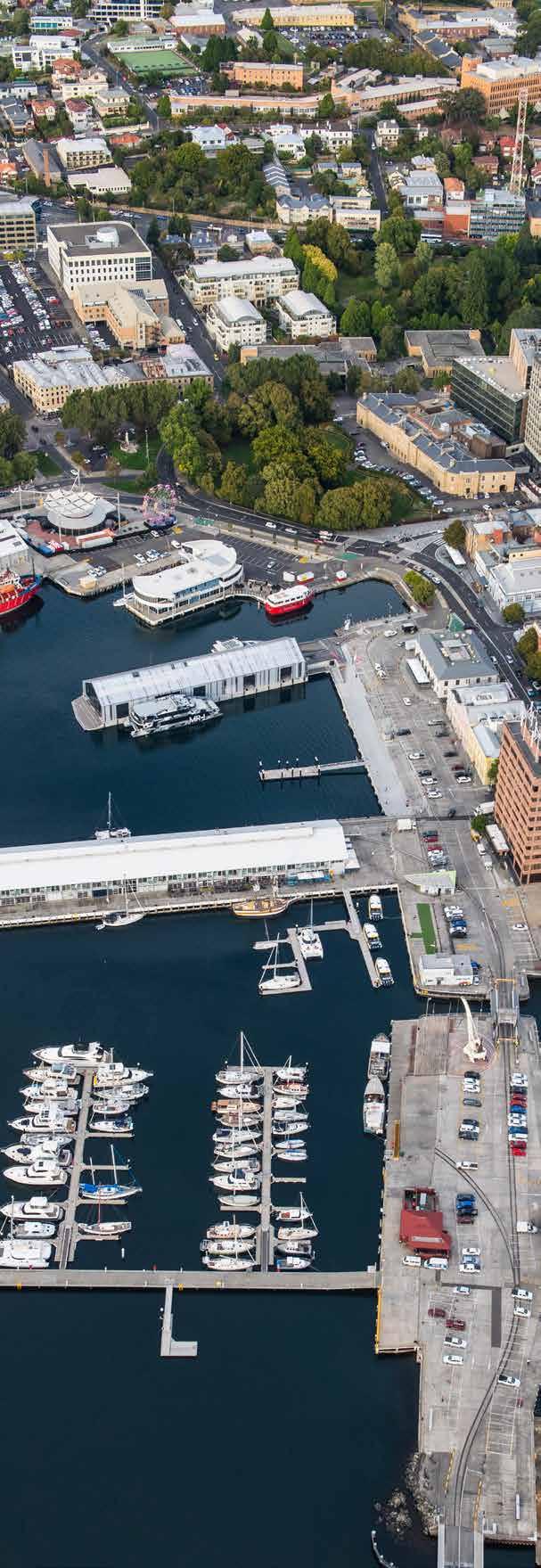
Hobart community members and stakeholders, in particular, the Community Panel, have called upon the City of Hobart to demonstrate long-term commitment to and strong governance of the vision.
The City of Hobart therefore commits to:
• showing leadership and demonstrating to communities and stakeholders that the future of Hobart will not be left to chance
• being an exemplar council, inspiring others to come on board with the vision
• acting as a guiding light in working for the benefit of communities, finding the common ground required to move forward
• approaching the vision with a spirit of partnership, actively seeking to work toward vision outcomes in collaboration with other councils, the Tasmanian Government, the Australian Government and other stakeholders
• using the vision to develop Council’s strategic planning, and following it through
• treating the parts of the vision as a whole, working with recognition that they all connect
• in choosing priority actions, ensuring the rationale is clear
• linking the vision with the reality of its implementation, recognising that each decision, no matter how small, affects the future of the city
• being accountable to the people of Hobart
• acting on lessons from success and failures, learning from mistakes and finding a better way, rather than shelving and forgetting them
• ensuring that the vision continues to reflect community values, needs and aspirations
• working with elected members and staff to ensure understanding of the vision, so that it remains central to Council thinking beyond election and planning cycles.
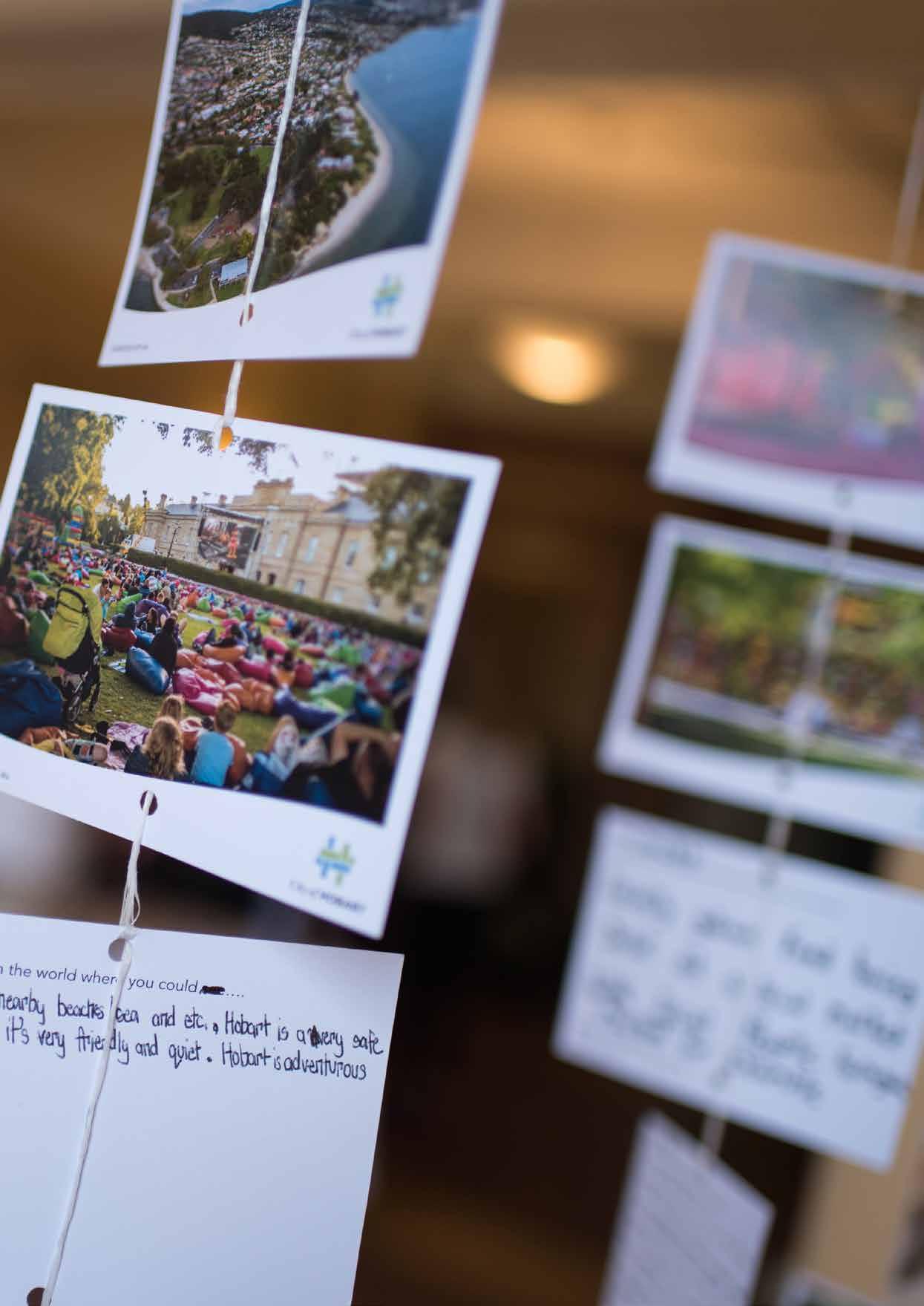
This document is the result of a deep enquiry into Hobart identity at a time of rapid change.
The aim of the project to create this vision was to understand more about Hobart’s particular spirit of place—what people love about this city, what they are most proud of, the examples of Hobart at its best.
The City of Hobart wanted to engage with Hobart residents, students, workers, businesses and visitors to hear about what this place means to people and better understand the issues we face as a city.
Although the project was facilitated by the City of Hobart, it has the Hobart metropolitan region in mind. Many people beyond those living within Hobart local government
• a first discussion paper investigating the trends and changes in Hobart over the past 10 years, to inform the decision to create a new vision
• a second discussion paper looking at city visions and similar initiatives in over 60 cities in 37 countries, to learn more about ideas that could be applied in Hobart
boundaries participate in and have a stake in the life of the city. Many important topics, such as transport and housing, also cross those boundaries.
The project used a combined research and engagement approach. Council staff worked alongside a team of consultants under the banner of The20, a Hobart-based marketing and communications agency. Community members and stakeholders guided and influenced the process along the way, as they contributed their stories, ideas and perspectives.
Over 1100 contributions have gone into the creation of this vision.
• 214 direct one-on-one interviews with greater Hobartians who live, work, study, access services and/or play in our city
• a blog with 20 posts revealing the themes that were being heard in our interviews
• the creation of a brief narrative about Hobart at its best, used to guide community engagement
• a two-day forum at the City Hall, attended by 116 people from across the Hobart metropolitan area
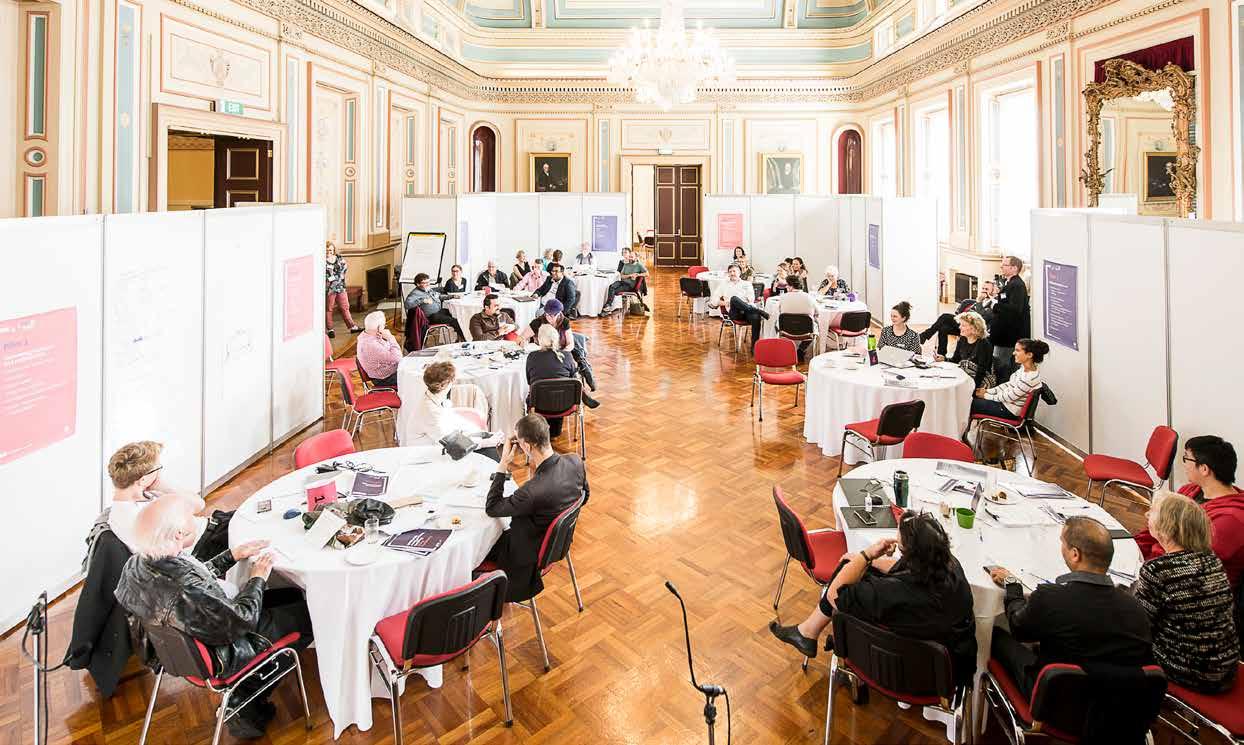
• a survey in the City News, sent to every residence and business in Hobart, and on Your Say Hobart, the City of Hobart’s online engagement platform, which received over 530 responses
• three pop ups in November 2017, at Salamanca Market, Farm Gate Market, and the Christmas tree lighting
• a workshop with over 50 Hobart primary school students, as part of Children’s Week 2017 celebrations
• three 2-hour workshops at the Hobart Town Hall, attended by 44 of the city’s key stakeholders
• written submissions from stakeholders
• a panel composed of 46 community members and businesspeople, who deliberated over these inputs to draft a new vision for the city
The majority of the Panel was a random sample recruited by an external market research organisation, EMRS. The panel was carefully selected according to a range of demographic criteria, such as gender, age and suburb, to ensure diversity and the best possible crosssection of greater Hobart communities.

Hobart is the capital city of the island state of Tasmania, Australia.
At 42.9 degrees south latitude, it is one of the most geographically remote state capitals in the world, alongside cities in New Zealand, Argentina and Chile.
Tasmania’s exposure to the Southern Ocean gives Hobart a temperate climate, with quickly changing weather and distinct seasons. The city is nestled in and around the space between kunanyi/Mt Wellington and the River Derwent.
At 1,271 metres, kunanyi / Mt Wellington—‘the mountain’—shapes Hobart’s weather and is a source of water for the city. Its altitude makes it home to some of the same species found in alpine regions across Tasmania. The Organ Pipes, the dolerite columns on its eastern face, are one of the most visible landmarks in Hobart. The Wellington Range provides a direct link from Hobart to the Tasmanian Wilderness World Heritage Area, in the southwest of the island.
The River Derwent has its headwaters at Lake St Clair in Tasmania’s Central Highlands, the deepest lake in Australia. Tidal seawater and fresh water mix in the Derwent estuary, supporting many species, including some, like the spotted handfish, found almost nowhere else. The River Derwent finishes at Storm Bay, an inlet of the Tasman Sea, which links Australia and New Zealand.
This geography connects settlements and local government areas across the region, from the Huon Valley to the Tasman Peninsula to the Southern Midlands and beyond.
The Hobart region is home to tens of thousands of years of Tasmanian Aboriginal history and culture. There are deep connections to places throughout the region, including numerous sites of significance along the Derwent estuary and in the kunanyi / Mt Wellington area. It was the country of the muwinina people of the South East Tribe.
The muwinina people walked this Country for thousands of generations. They gave birth on Country. They died on Country. The Tasmanian Aboriginal community continues to maintain
strong cultural identity today. Their connection to Country is unbroken. The mountain and the waterways, their food, rituals, and spiritual values, link people and culture to this Country.
The arrival of European explorers and settlers began a period of extreme disruption to the way of life in Tasmania. This history demands authentic reconciliation, a foundational element of thinking about the future of the city.
Dutch explorer Abel Tasman reported the first European sighting of Tasmania on 24 November 1642. Several French and British explorers sighted and landed on the island beginning in the late 1700s. Permanent European presence in the Hobart region began in 1803, with the British settlement at Risdon Cove, moving to Sullivans Cove, on Hobart’s present day waterfront, in 1804. Hobart has been the capital and the primary administrative centre of Tasmania since then. Its deep natural port, temperate climate and abundant fresh water made it an ideal base for industries, such as whaling, and a range of shops and services were established.
Between 1804 and 1853, around 76,000 convicts were transported to Tasmania. Thousands of women and children were imprisoned at the Cascades Female Factory in South Hobart between 1828 and 1877.
Some of Hobart’s most iconic landmarks and institutions were established in the 1800s, including Salamanca Place (1830s), the Theatre Royal (1837), the Mercury newspaper (1853), the Tasmanian Museum and Art Gallery (1863), the Hobart Town Hall (1866), and the University of Tasmania (1890). Hobart is a city of many inventions and firsts. For example, starting in 1893, Hobart was the first city in the southern hemisphere to use electric trams.
Hobart continued to develop through the 20th century. Although it is Australia’s least industrialised capital city, several well-known national and international companies, such as the Australian branch of Cadbury chocolates, Blundstone footwear, and the zinc works, were established in the region. Tourism has been a major industry for Hobart since at least the 1890s.
Along with all of Tasmania and Australia, Hobart experienced economic hardship several times since the city was founded, such as during the 1840s, the 1890s, the Great Depression in the 1930s, and the recession of the 1980s. But, in fact, Hobart and Tasmania have struggled economically for much of the time since European settlement. These downturns were difficult for many residents and businesses and slowed down development in and around the city. But they also meant that much of the original fabric of the city was maintained, at times when other cities built highways and skyscrapers.
Today, Hobart is known locally as one of the most liveable cities on earth. Here are some quick facts about Hobart, as of the Australian Bureau of Statistics 2016 Census:
• 224,462 people live in the Greater Hobart region, which includes the council areas of Hobart, Kingborough, Glenorchy, Brighton, Clarence and Sorell.
• The Hobart Local Government Area is 7,791 hectares in land area and is home to 51,750 people.
• It has a median age of 38.5 years, and 68.8 per cent of the population is between the working ages of 15 to 64.
• The proportion of the population aged 65 and over is increasing, making ageing population one of the key issues facing future Hobart.
• Nearly one quarter (22.7 per cent) of the Hobart population was born overseas; 82.6 per cent has Australian citizenship.
• Of those who work, 55.7 per cent travel by car, 15.4 per cent walk, 4.9 per cent take the bus and 17.3 per cent do not need to travel.
• As a capital city, Hobart’s services and amenities connect it to all of Tasmania. Over 50,000 people commute to work and over 30,000 to study in the city every day.

There are three parts to the vision:
The three parts reflect what people value about and aspire to for Hobart, to guide thinking about the future. They were developed through the vision community engagement process and are designed to complement and reinforce each other.
The three parts should all be used together, with the vision as a whole informing work on any single aspect of it.
1. 2. 3.
The vision statement is the overarching message about how to approach the future of Hobart.
The vision statement was created during the Community Panel and received the highest number of votes by panellists.
Decisions should be guided by this statement.
The Identity Statements are summaries of Hobart's stories, values and special qualities.
They are grouped into categories that make up parts of local identity:
1. Where we live
2.Where we come from
3. Who we are
4. How we relate
5. How we live
6. How we work
7. How we engage in civic life
They are about Hobart today—reflecting aspects of identity that should be reinforced, developed or improved.
Decisions should reflect, enhance and/or evolve these core aspects of our sense of place.
The eight pillars represent the major parts of city life:
1. Sense of place
2.Community inclusion, participation and belonging
3. Creativity and culture
4. City economies
5. Movement and connectivity
6. Natural environment
7. Built environment
8. Governance and civic involvement
The first pillar, Sense of Place, and the last pillar, Governance and Civic involvement, guide and reinforce each of the other pillars.
Each pillar has a number of focus areas—specific ways the pillars should guide strategic thinking about Hobart.
No pillar should be considered in isolation to the other pillars, or to the Identity Statements.
They are about Hobart in the future—reflecting some of what the city is now but also what we want it to become.
Decisions should reflect, enhance and/or evolve these core aspects of city life.
Important note: Many sections of the document use the word ‘we’, which refers to Hobart communities, not the City of Hobart (Council).
The vision statement was created during the Community Panel and received the highest number of votes by panellists.
The vision statement is the overarching message for the document—reflecting how to approach the future of Hobart.
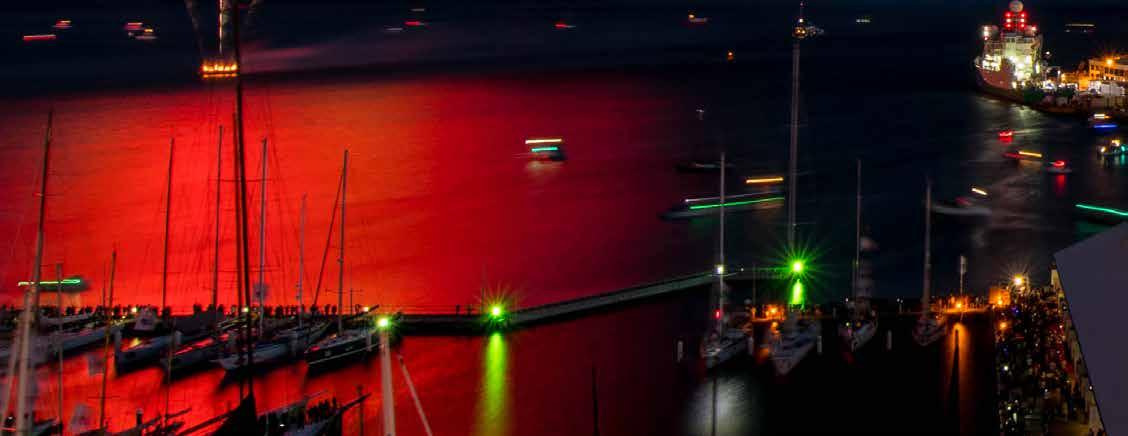
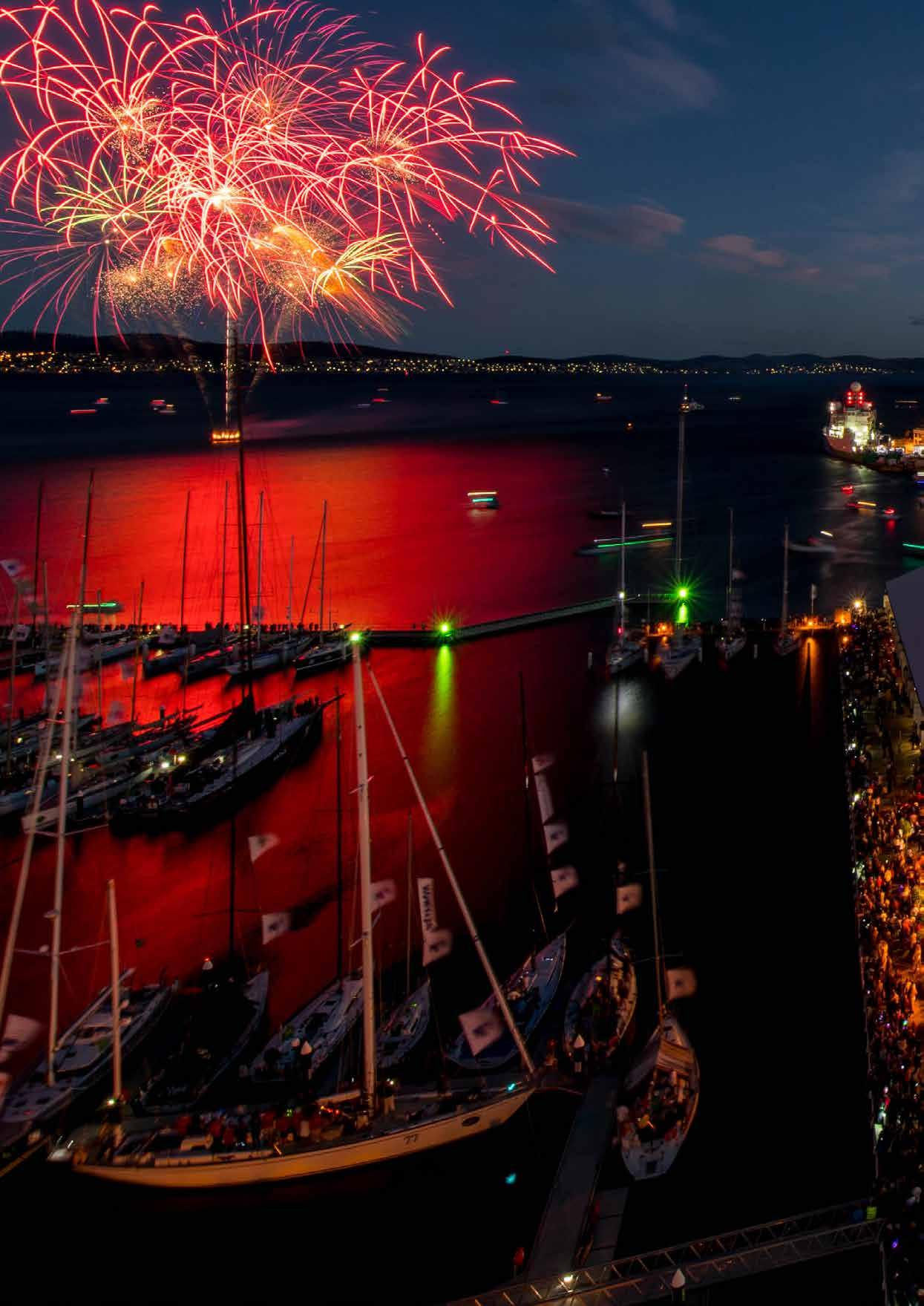
Hobart breathes.
Connections between nature, history, culture, businesses and each other are the heart of our city.
We are brave and caring. We resist mediocrity and sameness. As we grow, we remember what makes this place special. We walk in the fresh air between all the best things in life.
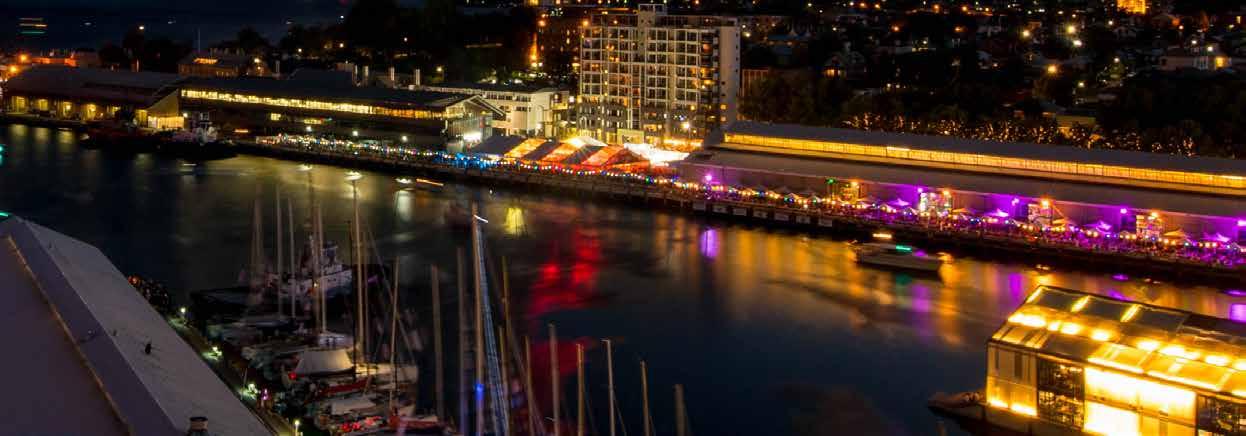
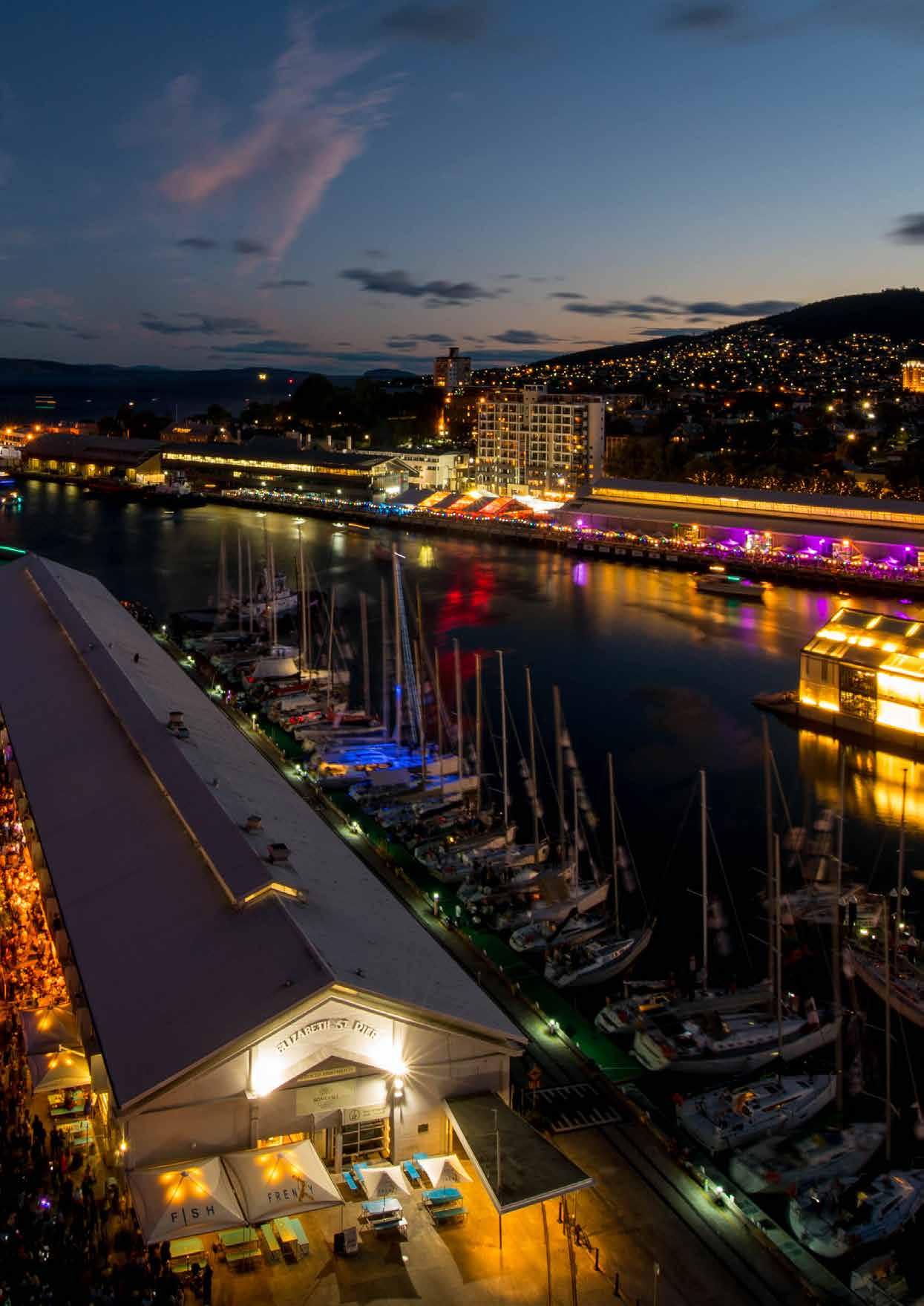
The identity statements are summaries of Hobart's stories, values and special qualities. These statements are built from what people said in interviews and surveys and at engagement events—the result of over 1100 contributions from people across the city. They are grouped into categories that make up parts of local identity.
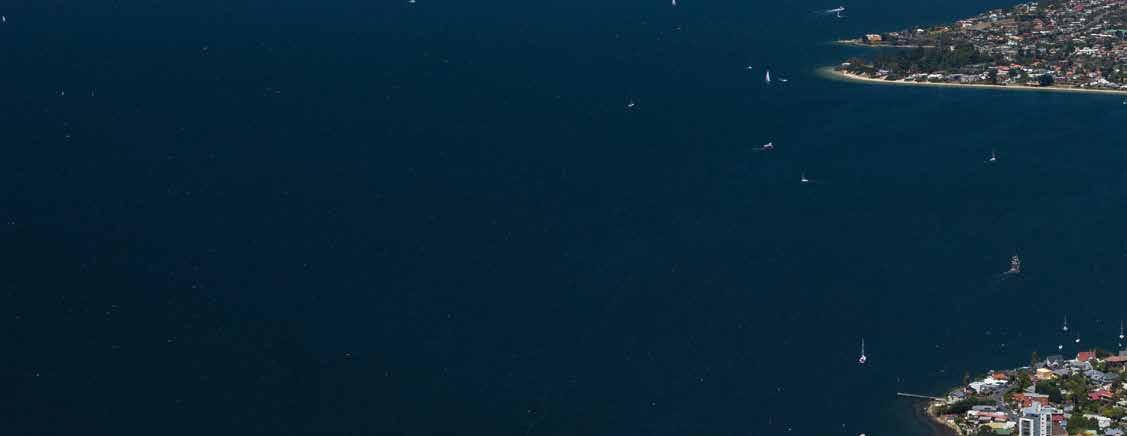

The identity statements are about Hobart today—reflecting aspects of identity that should be reinforced, developed or improved.
Not all of these statements, or parts of these statements, will speak to everyone but they represent the most powerful themes that emerged during vision community engagement.

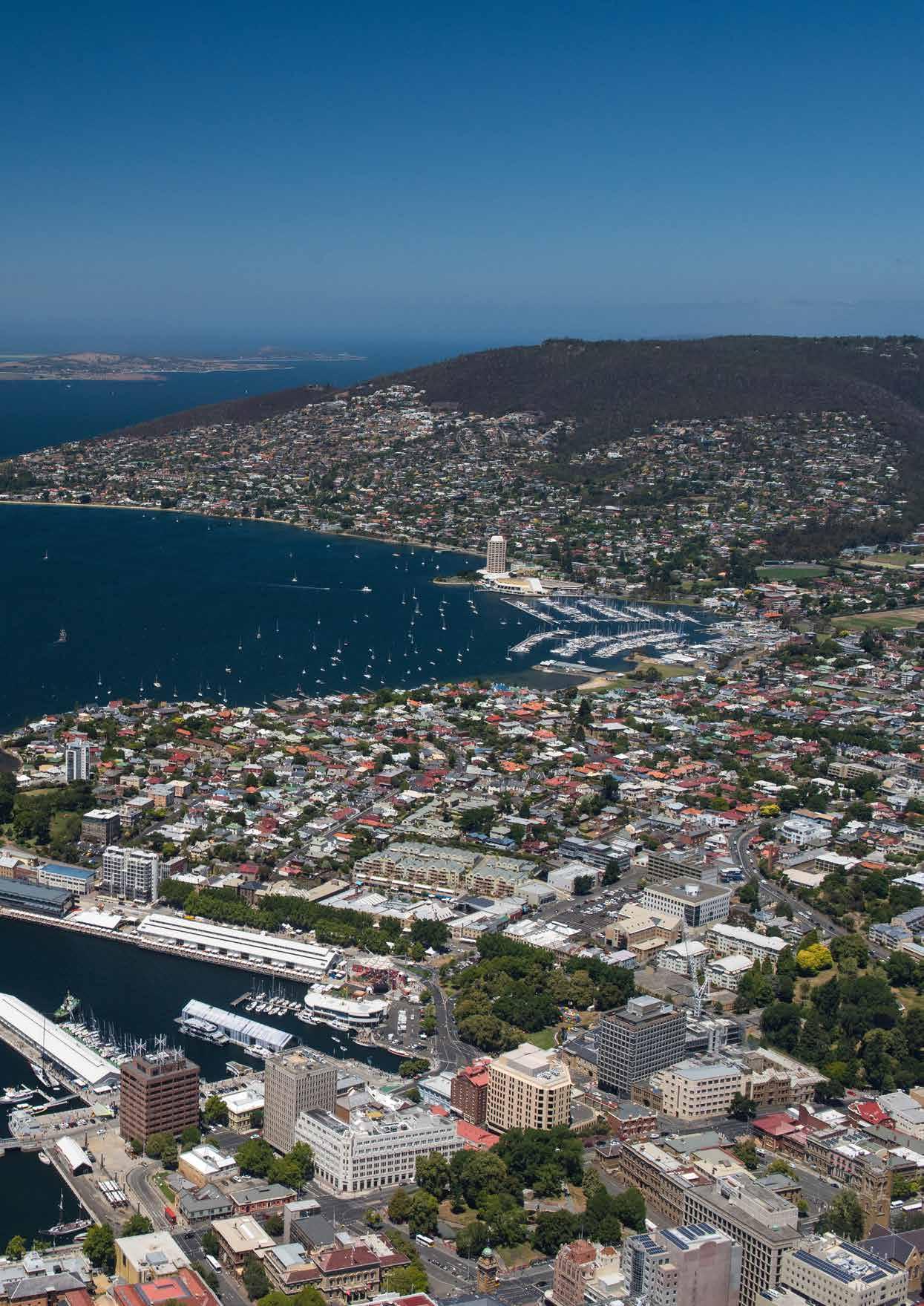
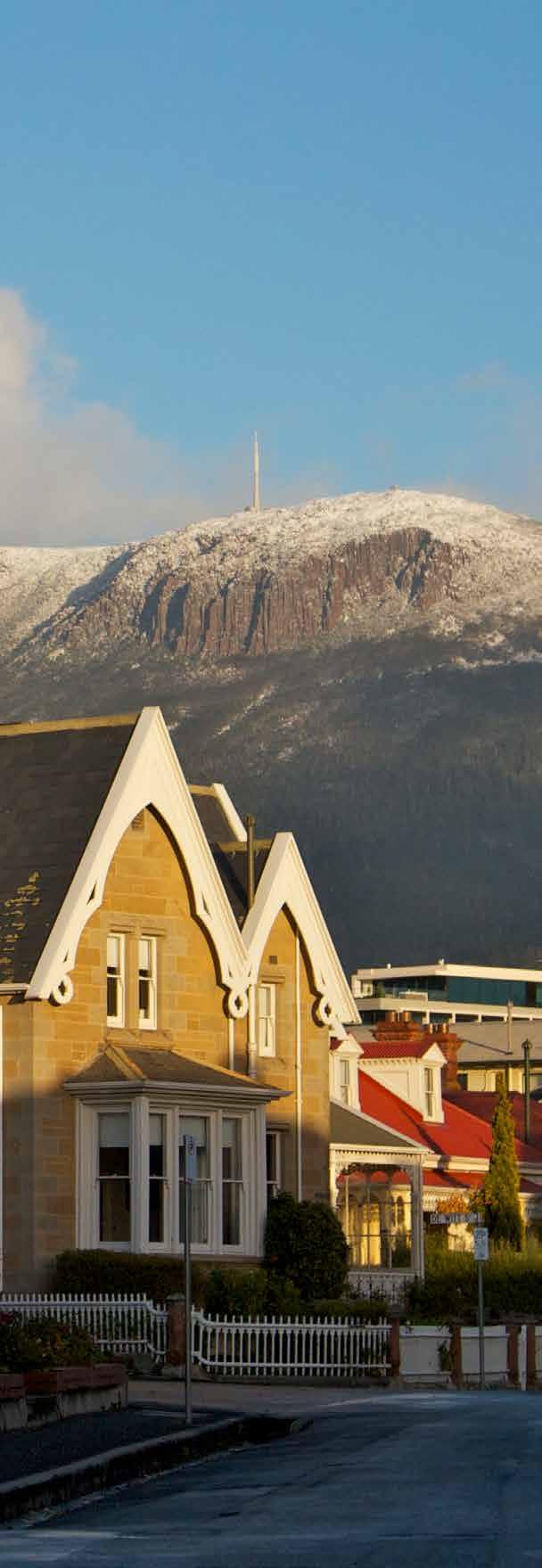
1.1. We are an island capital on the fringe of the Southern Hemisphere, a city defined by wild weather and its place as a gateway to Antarctica.
1.2. We are deeply connected to nature and wilderness, in, around, above and below our city.
1.3. Our geography and history guide the scale of our city: kunanyi / Mt Wellington, the River Derwent and heritage buildings are our most prominent landmarks.
1.4. We can access all the important parts of life, in a walkable and rideable city where we do not spend our lives commuting.
1.5. We want to ensure more of us have access to nature, and we should not take our ‘clean green’ image for granted.
Hobart is one of the most remote capital cities in the world, on the edge of an island on the edge of the Southern Ocean.
Even though plane flights, ferries and the internet have brought us closer to the rest of the world, we are proud of being a city on the fringe. Through centuries of isolation, we have developed a distinct personality and resourceful spirit. We can handle the weather and get things done—in rain, sun, sleet, snow, wind and hail (on the same day, at the same time). We are the Australian gateway to Antarctica. For those of us who travel, the blast of fresh air when we disembark at the airport is our welcome home.
We are intimately connected with nature and wilderness. Whether it is a quiet afternoon in one of our many parks, a commute to work along the Hobart Rivulet, or a day walking on the mountain (outside mobile range at only a few kilometres from the city), some of our best and most cherished times are in nature. The Aurora Australis is a regular visitor, and we can look up and see the Milky Way at a time when it is sadly missing from one third of humanity’s
night sky. Wallabies, possums, pademelons, wattlebirds and yellow-tailed black cockatoos visit our gardens—whether we like it or not.
The mountain, the river, and our history have given our city a special, human scale. This is one of the things we love most about Hobart. It feels like a city built for people, a city where our tallest landmark is kunanyi / Mt Wellington and the River Derwent draws much of our boundaries. Our heritage buildings are one of our greatest loves. Many of us can name specific examples of buildings we love and hate. We are proud of our sandstone buildings—especially at the intersection of Macquarie and Murray Streets, which has one on every corner.
Maybe most of all, we love how we can access the important parts of life in Hobart. We love that it is a walking city. Many of us walk to work, walk in the bush around Hobart, walk
our dogs and walk to visit family, friends and neighbours. We love being able to drive to our destinations quickly and park nearby. Many of us want to see the same ease of access happen with bike lanes and public transport, and for all Hobartians and visitors. We fear that more people and more congestion will make Hobart hard to move around, giving us less time to spend at home or with loved ones.
We know that not all of us have the chance to live so closely to nature, that some of us have never been to the mountain or seen our snow in person, and that our public spaces do not always feel safe. We love the quality of our natural environment, and how much less polluted it is now than it has been, but we know that our ‘clean green’ image is not a reality everywhere in our city and we still have a big journey ahead of us, as we face climate change and other threats to Hobart’s ecology.
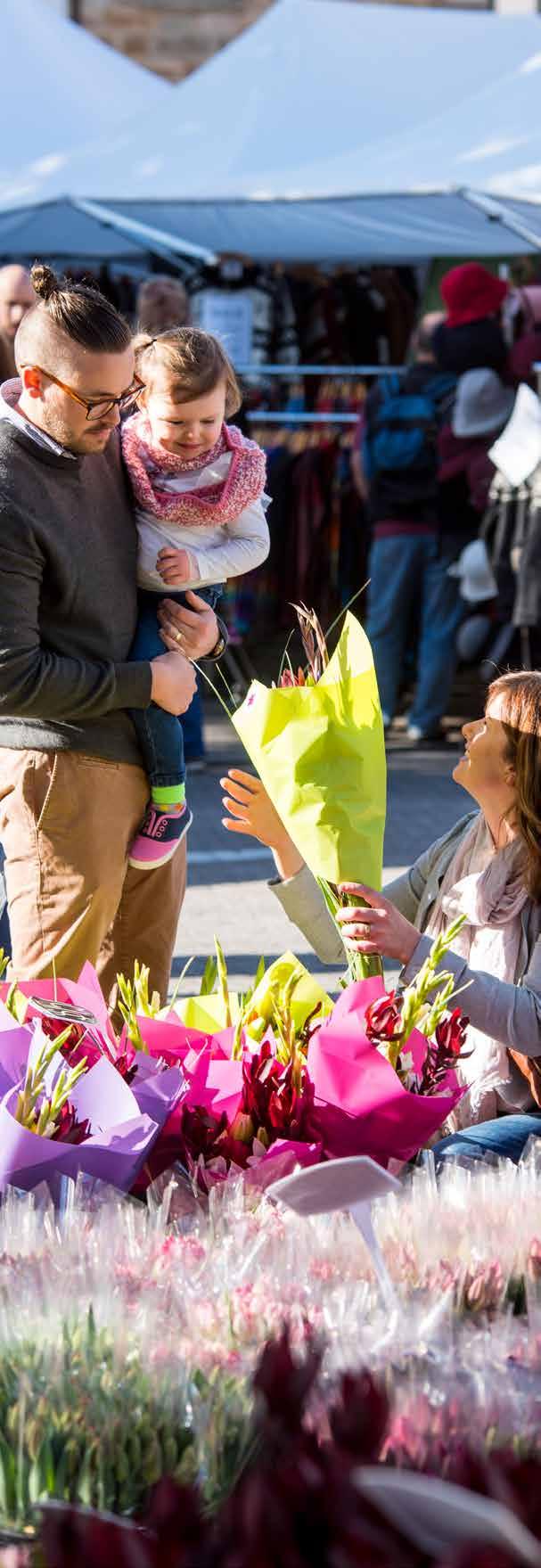
2.1 We are proud of our history, lineage and ancestry.
2.2 We are not yet reconciled with the darkness of our past.
2.3 We have been lucky to escape development during times when other cities were booming, and we embrace the best of ‘Slowbart’.
2.4 All of us in Hobart—who grew up and stayed, moved away (and sometimes returned) and moved here from elsewhere—are part of maintaining and evolving our city’s culture and feeling of home.
Many of us have a deep pride in our ancestry. Some have families who have been here for tens of thousands of years, building a deep connection with the land and each other. Others arrived toward the beginning of European settlement, as settlers or convicts. Still more have arrived from other parts of Australia and the world, as refugees, to study or to work in various industries in Hobart and around Tasmania.
But despite this pride, we are not reconciled with our history—with what happened in Hobart and in Tasmania. We have not faced the legacy of the Black War and related policies and what they have meant for Tasmanian Aboriginal community and culture. We feel conflicted about how, as much as we love the nature around Hobart, the last known thylacine died at Beaumaris Zoo, from neglect. We know that, although the tourism industry is booming, relying on single industries in the past made Hobart vulnerable to recessions. Many of us experience chronic disadvantage and trauma that our parents and their parents also experienced. We want to find a way to move forward, together.
In some ways, Hobart has been lucky to escape development. When other cities around the world were booming, they demolished heritage buildings to make way for new, taller ones. They put in superhighways and sprawled out as far as the eye could see. Many of us said that we were lucky to have missed out on that—even though it was hard at the time and led others to think that Hobart was living in the past. Now, we think of ‘Slowbart’ as a compliment and a source of pride. We are becoming more confident about who we are, knowing that we have what many cities have lost: human scale and connections.
Some of us struggled to describe what is special about Hobart.
Many of us who have always lived here simply know or love this place without needing to put words to it. We have gone through a journey of seeing its good times and bad times, and we are the stewards of the stories of Hobart at its best and worst. We enjoy travelling when we can but travelling also reminds us of how good we have it in Hobart.
Some of us who grew up here and had the opportunity to leave, did. We left to study, to work, to find new experiences in bigger places. But perhaps one of our most common stories is returning to Tasmania for a visit and being called back home. Having gone on our pilgrimage to the rest of the world, we return with new knowledge and ideas, and a new appreciation of how this island is like nowhere else on earth.
Many of us who moved to Tasmania from elsewhere felt that same calling—like coming home to a place we had never lived in but knew was right.
3.1 Hobart is a place where we can be ourselves.
3.2 We prize honesty, authenticity and modesty.
3.3 We help each other in the best and worst times, and we flourish in the face of hardship.
3.4 Our city feels friendly and safe—but we know not everyone experiences our city this way, and we could do better.
At our best, Hobart is a place where we can be ourselves. Especially those of us who have moved from elsewhere have found peace in moving to Hobart, where there isn’t the same push to join the ‘rat race’ as there is in bigger cities. Hobart demands honesty and authenticity. Many of us love how Hobart is not an arrogant or pretentious city. It is the type of place where we can wear a black puffer jacket, affectionately known as the Tasmanian Tuxedo, out to dinner. We prize our modesty: our way of getting things done and making life better for other people, without needing awards or recognition.
In Hobart, we help each other. As the rest of the world becomes more and more individualist, Hobart has kept a community feel. Many of us talk about holiday street parties, helping neighbours as they grow older, volunteering and giving back in honour of those who helped us. We have all experienced, or at least heard about, the bushfires of 1967 and the day the Tasman Bridge went down in 1975. Although these were painful and challenging times, many of us have stories of how these disasters are symbols of Hobart at its best.
We are not only resilient in the face of hardship— we flourish. When the bridge went down, INCAT was born, and its catamarans can now be found everywhere from Saudi Arabia to Argentina.
We especially love our city’s friendliness. Some of our favourite parts of day-to-day life are about striking up a conversation with a stranger, smiling at each other on the street or defaulting to a person (instead of a smartphone) to get directions. Many of us talk about how safe our city feels compared to others we have lived in.
But while we value our authenticity, modesty and friendliness, we also know that not everyone experiences our city this way. We do not all automatically feel welcome or included or like we know how to navigate this culture. We do not all feel safe. And so while we know that Hobart has the community qualities that many places have lost, we also know that not everyone feels a part of that and we could do better—and for that, we would all be better off.
4.1 Hobart is a city of chance encounters and collisions with friends and neighbours.
4.2 The connections between us are strong and help us get things done.
4.3 The scale of our city helps us meet and learn from people not like us.
4.4 We could make our connectedness more inclusive and inviting.
Some of the best things in life come as a surprise. In Hobart, we sometimes feel like not much changes. But one of the defining features of Hobart life is the chance meetings that happen almost every time we leave the house. At the supermarket, on a mountain track, or on our way to pretty much anywhere, we run into people we know and arrive at our destination sometimes hours later than we planned. We have a love-hate relationship with these encounters. They are one of the richest parts of daily life, a sign that we are among friends. But there are some particularly hectic days

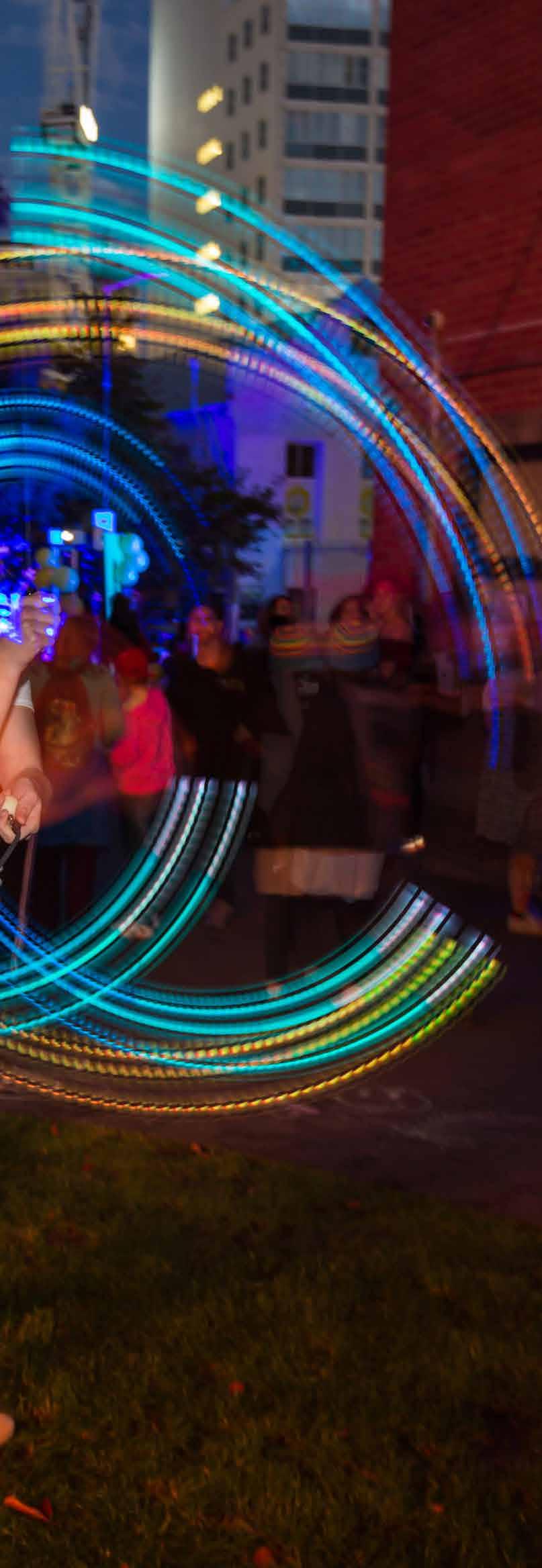
when we would rather be anonymous. For many of us, though, this is a small price to pay to know we are part of a community where people recognise each other.
The connections between us are strong. Our networks bring us closer to people across the city and the island. They mean that we can get things done quicker, cheaper and better than if we were going it alone. Many of us have stories about hatching an idea and needing a hand, only to have all the help we could ask for organised in a day or less. Word of mouth is powerful everywhere but it is very powerful here. Combine this with our friendliness and willingness to help, and we can launch anything.
These connections and collisions are at the heart of what makes Hobart Hobart. Many of us talked about being part of a community where they feel understood. At the same time, we live in a city small enough where we have the chance to run into people not like us and get to know them—growing our own skills and understanding of the world in the process. We love seeing suits and hi-vis at the same pub.
Of course, close connections are not always easy. Some of us say that it is difficult to recover from making an enemy or a mistake in Hobart. Recent arrivals to Hobart sometimes feel that such close-knit groups of friends are not open to newcomers. As we move through our working lives, we can find ourselves on the outside of well-established networks and wonder how we will ever make our way in the world. If we lack the resources, knowledge, skills, ability or motivation to participate the way other people do, how do we get involved in city life? Those of us who find ourselves feeling outside a majority culture, whether at school, work, or in Hobart more generally, can struggle to find a meaningful connection with the city and may find some chance collisions less than friendly. Many of us are looking for ways to make Hobart connections more tolerant, inclusive and inviting.
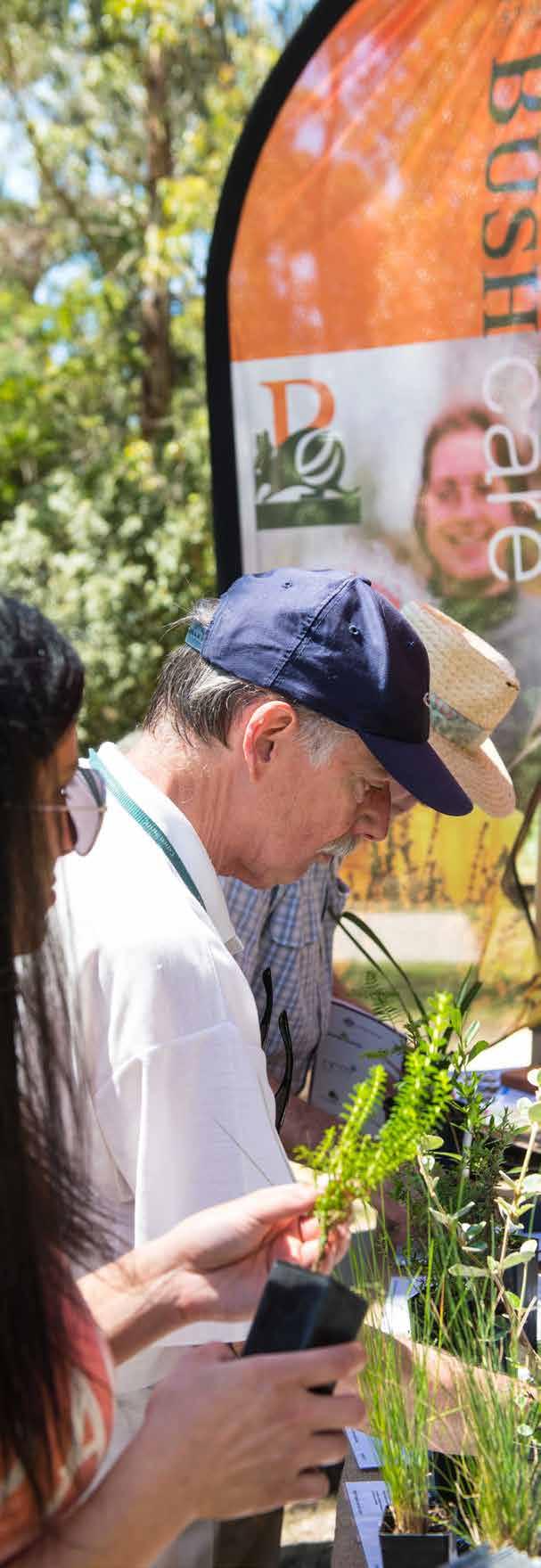
5.1 Life in Hobart is not just about the money: we prize our time, meaning and fulfilment.
5.2 We celebrate, in daily life and through our many events and festivals.
5.3 We are a small city with the cultural wonder of a capital many times our size.
5.4 We are a city of well-loved artists, creators and cultural institutions.
5.5 We are concerned that, in a city known nationally for its affordability, increasing costs of living are excluding people from the ‘Hobart lifestyle’.
5.6 We want our economy, and especially tourism, to focus on quality over quantity.
In Hobart, it’s not about the money. Some of us say that it is Hobart itself that is the jewel. The way of life here—the access and connections to people, nature and meaningful pastimes—is priceless. Many of us value fulfilling or part time work over a bigger salary. Many of us have stories of being lured to ‘the mainland’ by the possibility of career progression and a pay rise. Many have gone elsewhere to gain experience and perspective, knowing we wanted to return. We have at least a loose idea of the statistics—that houses are technically cheaper than they are in other major cities and that the cost of living is lower. While these practicalities make a difference, we also know that there is so much more to life that doesn’t have a price tag and that, here, we can be among people who share those values.
Many of us talk about a different concept of time in Hobart. Our city is not in such a hurry. We take the time to appreciate the simple things, like walking to the local shop or working in the garden. We love to celebrate—Hobart’s calendar of events and festivals is one of the best-loved parts of city life. Whether it is the summertime arrival of the Sydney to Hobart yachts and the Taste of Tasmania, or the wintertime glow of Dark MOFO and the
Festival of Voices, we are proud of creating, sharing and welcoming culture in many forms.
We marvel at how Hobart is a small city and yet has all of the wonder of a capital many times its size: a thriving underground arts and music scene, the Tasmanian Symphony Orchestra, the Theatre Royal, the Tasmanian Museum and Art Gallery, the University of Tasmania. And, of course, MONA, a symbol of creativity and rebellion that has become an institution. But we know that our institutions do not have a monopoly on our creativity; we are as proud of our individual writers, artists, performers and philosophers. We are proud of our tech and design industries, our excellence in the trades, and in science and research across many fields.
Many of us summarise all of this as the ‘Hobart lifestyle’. But we also know that not everyone has access to this lifestyle. We are worried about the increasing cost of living—and especially the increasing cost and decreasing availability of housing, even more so for those of us with the least money. We are conscious that, for some of us, it is all about the money because the Hobart lifestyle is outside of what we can afford. There is inequality and disadvantage present across our city, and we fear that it’s getting worse.
We are excited about tourism and welcoming people to our city and our island. With these new visitors come opportunities, to encounter new cultures, share our knowledge, and make a living through providing them with products and services. Many of us first came to Hobart on holiday and were so captivated that we never left. But we are afraid of Tasmania’s tourism focusing on quantity instead of quality. We don’t want mass tourism at any cost. As one of us said, we want to invite visitors to ‘live like a local’, which means seeking quality experiences at Hobart’s pace of life, rather than ticking Tasmania off a bucket list.
6.1 We prize our inventiveness, resourcefulness and creativity.
6.2 We are multi-skilled tinkerers, artisans and craftspeople, we are a city of niche professions and industries.
6.3 We have an entrepreneurial spirit: our city is our workshop and our markets are our small business incubators.
6.4 We collaborate, using our city’s scale and connections to grow and improve.
6.5 We are concerned that some of us are being left behind as we grow, and growth and change could have negative impacts on our way of life if not planned and managed well.
Our histories, geographies and cultures have all helped form how we make our way in the world. One thing we love about Hobart and Tasmania is our way of getting things done.
We are especially proud of our inventiveness and resourcefulness, our way of finding creative ideas and solutions. We all have stories of this phenomenon—from local breweries and distilleries to rock lobster hatcheries. We live it daily. Hobart is a city of tinkerers, artisans and craftspeople, constantly experimenting, building and modifying. We might not personally identify with these attributes but we see them all around us. Many of us have a range of skills that might surprise people from big cities, which are often so busy and specialised that there is little time left to learn a new skill.
As a home to the University of Tasmania, Hobart boasts a thriving student population and experts on topics ranging from Antarctic glaciers to alpine mosses. Many Hobartians are also proudly self-taught and find great joy in teaching others. Hobart is a place for the novel and niche. Many of us think of Hobart as a workshop or an incubator—a place where new ideas can be tested and then taken to
the world. Hobart also sometimes benefits from being the last to try new things. Lessons learned elsewhere can be applied here, the Hobart way.
The most common examples can be found in Hobart’s small businesses and markets. Many of us talk about Hobart’s entrepreneurial spirit. We were so isolated, we had no choice but to be multi-skilled and solve problems ourselves. So we start our own businesses, and what better way to test them than at the markets? Many of us think of Hobart’s many markets as a way for Tasmanians, from Hobart and around the state, to create a product, build a following, and expand their businesses. We start small, using our scale and our connections to grow. We are as collaborative as we are competitive—each of our successes is a success for all of us.
Some of our favourite examples are of foods and beverages. We are proud of how much food is grown in Tasmania, and we value being able to access it locally. We love the growing number and quality of our restaurants and cafes—but we don’t want to be like Melbourne. We love local producers and are happy to support them through buying their products.
We wonder what growth in and near the city will mean for our creative, entrepreneurial spirit. What if artists can’t afford to live in Hobart? Or if producers can’t afford to grow their fruit and vegetables in the Huon Valley? What if tourism becomes so big that the majority of Tasmanians can’t afford to buy anything at local markets or businesses? How do we improve educational outcomes and still prize everyone’s individual skills and strengths? We see these possible changes on the horizon and don’t feel confident that there is a plan to keep this place special.
7.1 We are active on issues that are important to us.
7.2 We feel collective ownership of and responsibility for our city.
7.3 Government is a big force in city life and we want it to reflect and reinforce what we value about Hobart.
7.4 As Tasmanians who live in Hobart and Hobartians who live in Tasmania, we are connected to our region and our island.
Many of us are proud of our active, grassroots spirit, which we apply to business but also to how we engage on issues that affect us. We recall times when we worked together to stop or start something that we felt was important for our city or our state. Many of us value how Hobart’s smaller population means that people have greater access to power. We might see the Premier or the Lord Mayor walking down the street, for example, which would be far less likely to happen in a big city.
We have a strong sense of the commons, talking about our mountain, our parks, our city, because we feel a sense of collective ownership of and responsibility for them. We also feel responsible for our communities, and some of us wonder how we can extend that sense of responsibility and kindness to even more people in Hobart.
Many Hobartians agree that government is a big force in city life. Local, state and federal government agencies are major employers— some of the biggest in the state. We value government as an employer and service provider.
But when we talk about our government, many of us wonder why it doesn’t seem more like our people: in a city built on connection, authenticity and inventiveness, our government can feel distant, complicated and slow.
We don’t always understand how and why decisions are made, and we wonder how to engage when our lives are already so busy. We want to receive support rather than blockages when we have a new idea, and if it won’t work, we want to understand why.
Despite our frustrations, there are some things we are very proud of. We love our parks and reserves. Many of us are excited to see new infrastructure and public space projects happening as a result of the 2010 Gehl Report. We love public art, even if we don’t agree on which pieces are beautiful. We love getting compost from the tip and volunteering with Bushcare. We love seeing better quality public toilets, taking visitors to Salamanca Market, and seeing our heritage buildings preserved.
We know that we are a capital city. Some of us identify as Hobartians; many of us identify more strongly as Tasmanians. Perhaps more than in other cities, we know how strongly we are connected to the places that provide us with food and water, where we often go away on weekends or commute to and from every day. Many of talk about how residents, commuters and visitors alike do not experience Hobart according to local government boundaries. We want to know how we can think in more metropolitan ways about big issues like transport and housing.
As we move into the future, we want to know that our governments will both listen to the people and provide leadership. We want to know that there are well-thought out plans that go beyond election cycles.
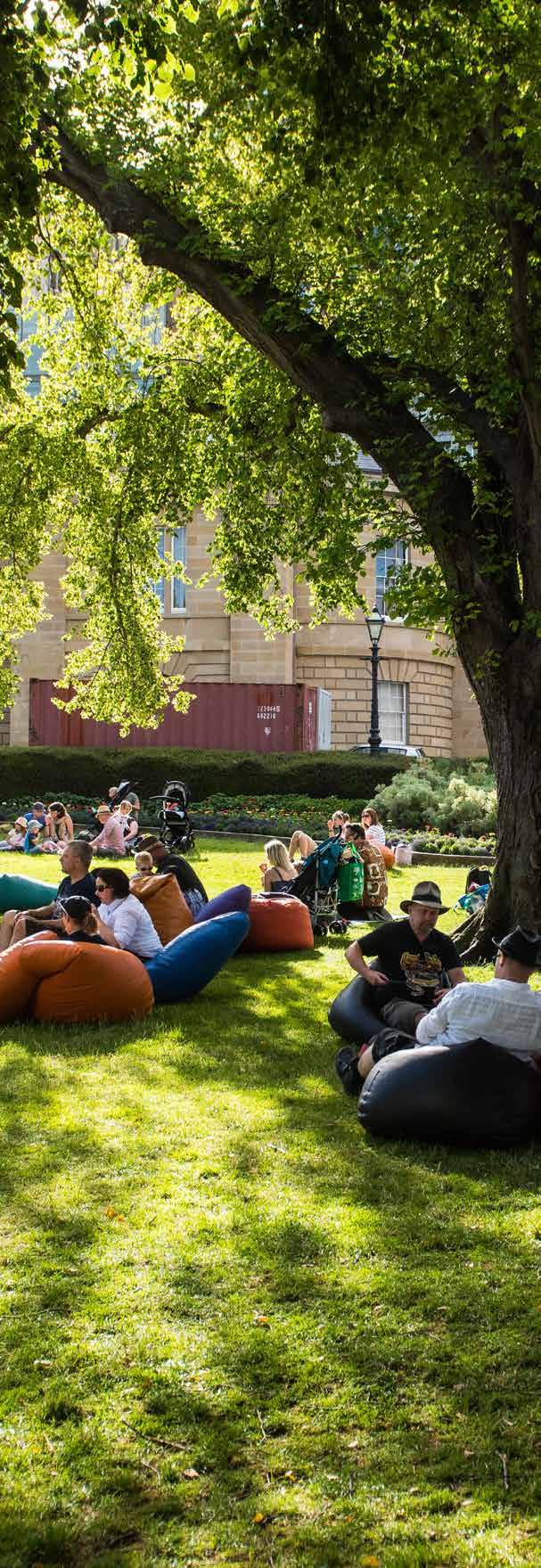
The eight pillars represent the major parts of city life.
The pillars were first drafted through the City Forum, where participants were asked to name and vote on the key things they believed should guide the vision. These recommendations, combined with research findings on the categories that city visions typically include, formed the pillars in this document.
The Community Panel developed the pillar and focus area content based on their experiences, readings of engagement findings and input from subject matter experts. City of Hobart staff collaborated with panellists to finalise the pillars and focus areas.
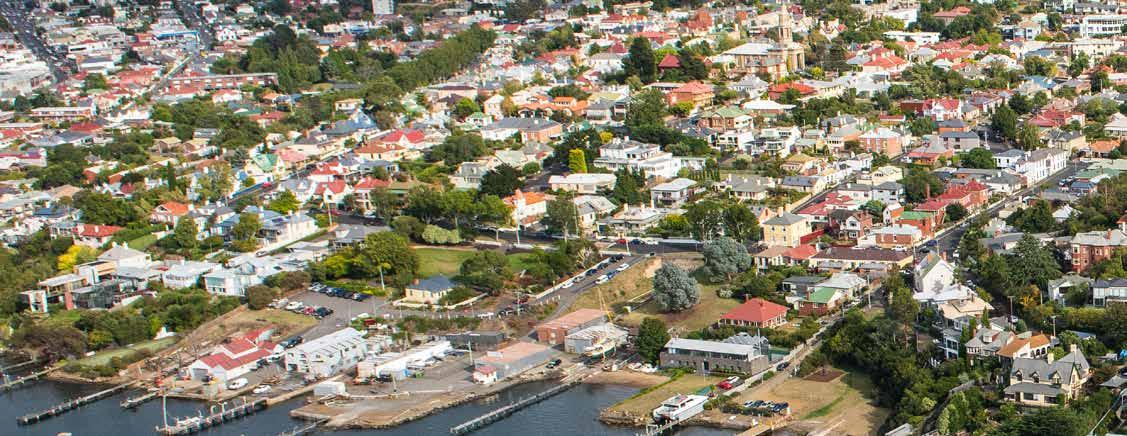
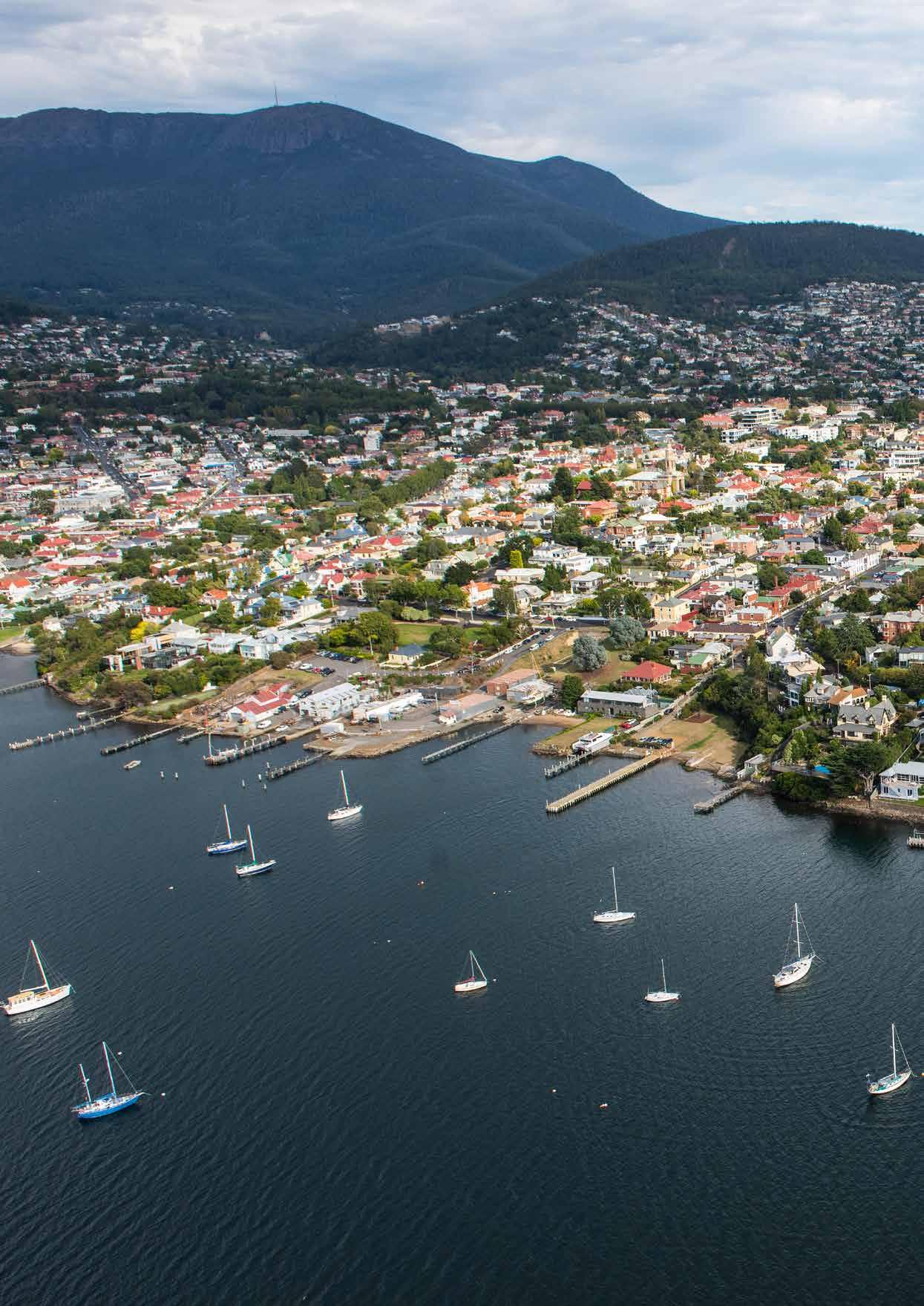
The first pillar, Sense of Place, and the last pillar, Governance and Civic involvement, guide and reinforce each of the other pillars. Each pillar has focus areas—specific ways the pillars should guide strategic thinking about Hobart.
No pillar should be considered in isolation to the other pillars, or to the identity statements.
The pillars are about Hobart in the future —reflecting some of what the city is now but also what Hobart communities want it to become.
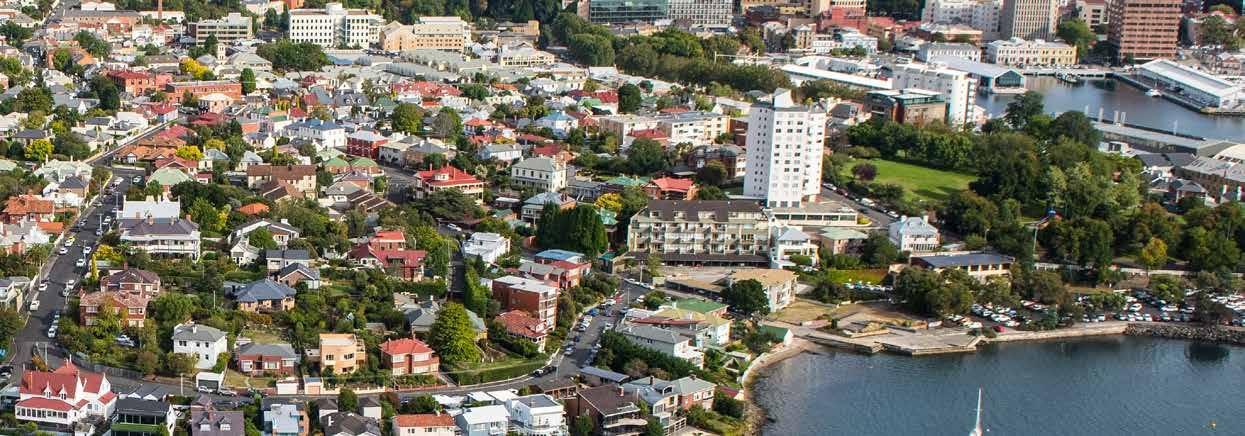
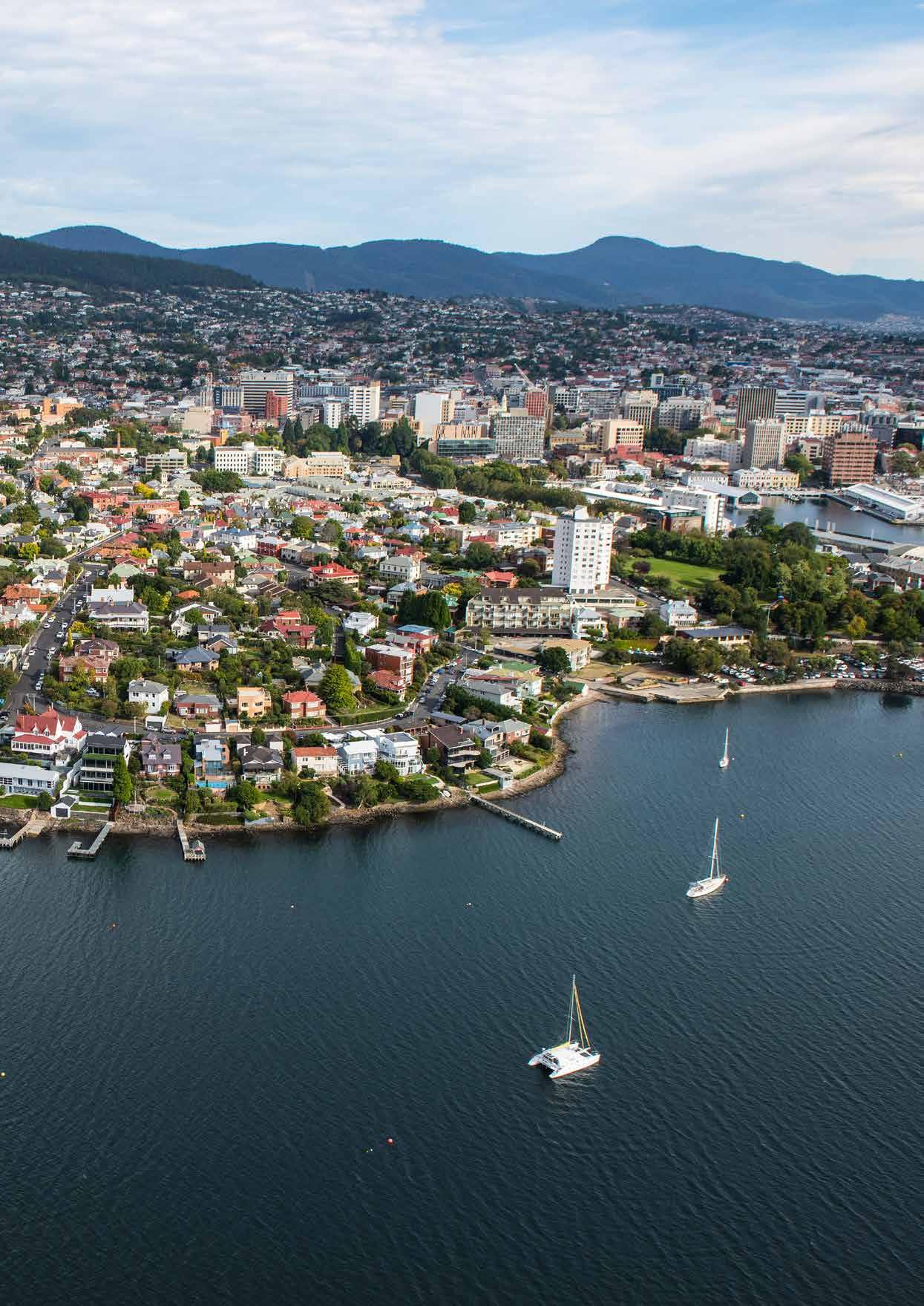
We are a city of unique beauty, environment, heritage and people, built on a shared sense of ownership, pride and wonder. This spirit of place has been shaped by Tasmanian Aboriginal people for tens of thousands of years and continues to be shaped by all who have called Hobart home. It is developed jointly by community, private enterprise and government, valuing and enhancing our Hobart identity.
1.1 OUR SPIRIT OF PLACE IS STRONG
1.1.1 Hobart is home. We invite everyone into this feeling.
1.1.2 We all have individual experiences of being here but we recognise that there are some elements—like the mountain, the river, our heritage, culture, and human scale—that resonate so strongly with so many people that it brings us together.
1.1.3 Many of us carry a strong, spiritual connection to place. This value may be intangible but it is highly significant.
1.1.4 We recognise that some of what we value is beyond words and not easy to quantify—we embrace rather than fight this complexity.
1.1.5 Our spirit of place fills us with pride and inspiration. If we had to leave Hobart, our sense of place is what it would break our hearts to lose.
1.2.1 Our personal histories and experiences, our stories, histories and myths and the values and beliefs we share bind us to this place.
1.2.2 We have a sense of connection to place and community that gives meaning to our lives. We recognise the strength in those who are committed to this place—because of what it is and who we can be here.
1.2.3 We appreciate that we each have different ideas of what this city means to us and how we would improve it. We allow our understandings of our place to evolve through personal experience. We use differences of opinion to test our ideas.
1.2.4 We recognise that people’s ideas of Hobart are influenced by where they come from, where they are and where they are going. Some of us are attracted to Hobart because it ‘ticks the boxes’; some move or stay here because we have to. But we make sure that we
all have the opportunity to develop the deeper meaning and connection that has made Hobart’s sense of place so strong.
1.2.5 We don’t take our sense of place for granted. We learn and apply lessons from elsewhere at the same time that we avoid changes that weaken it.
1.2.6 Our sense of place supports growth and progress that is consistent with our vision. The strength of our connection to our current way of life does not encourage us to stagnate but rather provides guidance for us to move forward.
1.3.1 We acknowledge these attributes as important for our vitality, inspiration and health. We embrace our good luck in having a sense of wonder and beauty that many cities have lost.
1.3.2 We consider our natural surroundings, maintaining clear line of sight from major public spaces to the mountain and the river.
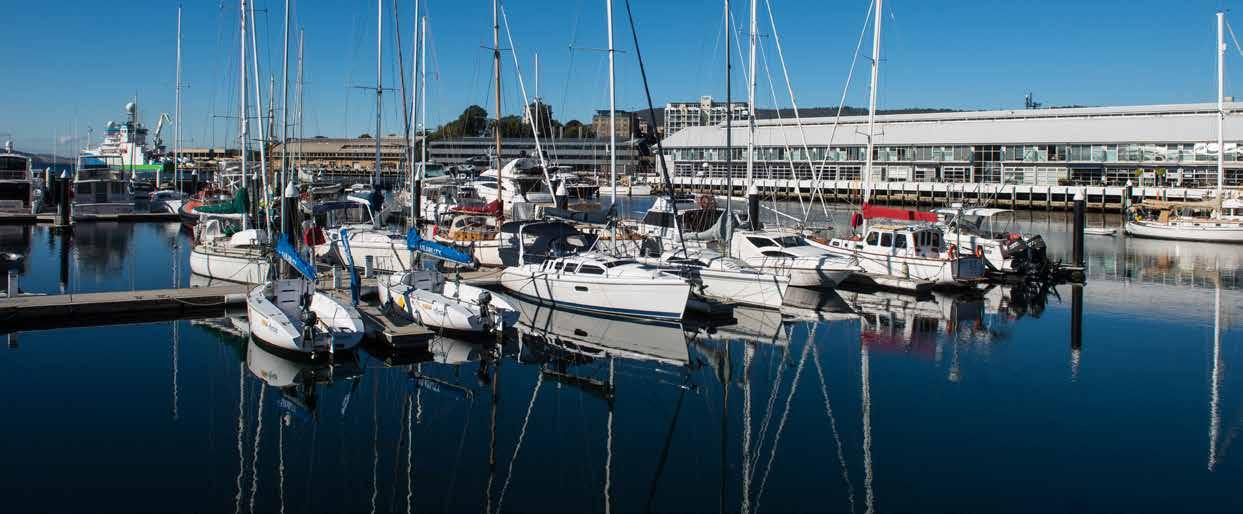
1.3.3 We create and retain spaces where people feel connected with Hobart, each other and the environment, where we are safe, engaged and inspired.
1.3.4 Open and natural spaces bring peace and inspiration to our lives.
1.3.5 Striking building architecture, landscape design, and public sculpture and art installations reflect our identity and project our Hobart stories.
1.3.6 People want to spend time in our city because it is comfortable, safe and wonderful. Our visitors feel a sense of friendliness and magic that they miss when they leave.
1.4 WE THINK OF OUR CITY AS A WHOLE
1.4.1 We recognise the interconnectedness of the parts of city life, which includes all aspects of identity and each of the pillars.
1.4.2 We think of our city as a system, where built, natural and human environments are part of each other.
Our people, geography, climate, ecosystems, buildings and infrastructure all make Hobart what it is and reinforce a strong sense of place.
1.4.3 Our spaces are well connected to one another. They are inviting, diverse, attractive, and safe and inspire movement. They include space that we value for offering peace, quiet and reflection. They maintain the community feel of Hobart.
1.4.4 We undertake a continual and considered process of change as development evolves, to uphold our city’s identity.
1.4.5 We maintain the heart of our city. Scale and design must preserve and nurture our community and connections.
1.4.6 Our rich historical legacy is respected, shared and celebrated, whilst we welcome and encourage the new.
1.4.7 We engage and work with developers to help them understand the Hobart context and how
their developments can contribute.
1.4.8 We call on developers and architects to prove their fit—to convey how their developments support our vision and identities. New developments avoid mediocrity and celebrate, enhance and evolve our identity instead of simply capitalising on current trends. Given our limited available space and the lasting nature of major constructions, we demand a high quality of design that will continue to make us proud many years into the future.
We are an island capital city that is socially inclusive and coherently connected, whose people are informed, safe, happy, healthy and resilient.
2.1 WE CELEBRATE TASMANIAN ABORIGINAL COMMUNITY, HERITAGE AND CULTURE
2.1.1 We recognise the Tasmanian Aboriginal community and their heritage and culture as the foundation of this place.
2.1.2 We acknowledge the darkness of our shared history and work toward authentic reconciliation.
2.1.3 We support the Tasmanian Aboriginal community to practise their traditions, skills and customs so they may be passed on to future generations.
2.1.4 Our city learns from the original and continuing custodians of this land. We support projects and programs that educate us all.
2.1.5 We engage respectfully. We are patient and acknowledge that we all have different ways of working. We actively engage on important projects.
2.2 WE CELEBRATE OUR DIVERSITY AND INCLUDE EACH OTHER IN CITY LIFE
2.2.1 We make Hobart the most inclusive city in the world, a city that welcomes all.
2.2.2 We celebrate the variety of ways that we belong and the variety of communities of which we are a part.
2.2.3 Diversity in culture, nationality, ethnicity, race, gender, sexuality, ability, age, body, family, recreation, profession, personal strengths, income level, language, education, life experiences and more make up each of us and, together, make up our city. We recognise and embrace the rich complexity diversity brings to our lives—we are all part of creating Hobart’s identity.
2.2.4 We listen to the voices and wisdom of children and young people in our communities. Children and young people have diverse, high-quality opportunities for education, employment, housing and personal growth in Hobart as they move through life. As we
grow up, we inherit a high quality of life, including meaningful ways of staying in or returning to Tasmania, if we so choose.
2.2.5 People with a disability are afforded the same opportunities to participate fully in community life, regardless of physical or mental capabilities.
2.2.6 Hobart is a place for all stages and types of the life course. Families, parents, children, single people, couples, friends, partnerships and older people can find home here.
2.2.7 We recognise and face inequalities, poverty and disadvantage in our communities.
2.2.8 We support each other to have our needs met and flourish. We all have opportunities to access and contribute to Hobart life.
2.2.9 We welcome visitors, and we strike a balance between meeting the needs of tourists and the needs of our communities.
2.2.10 We are all sincerely valued. We respect each other. We all have the chance to belong.
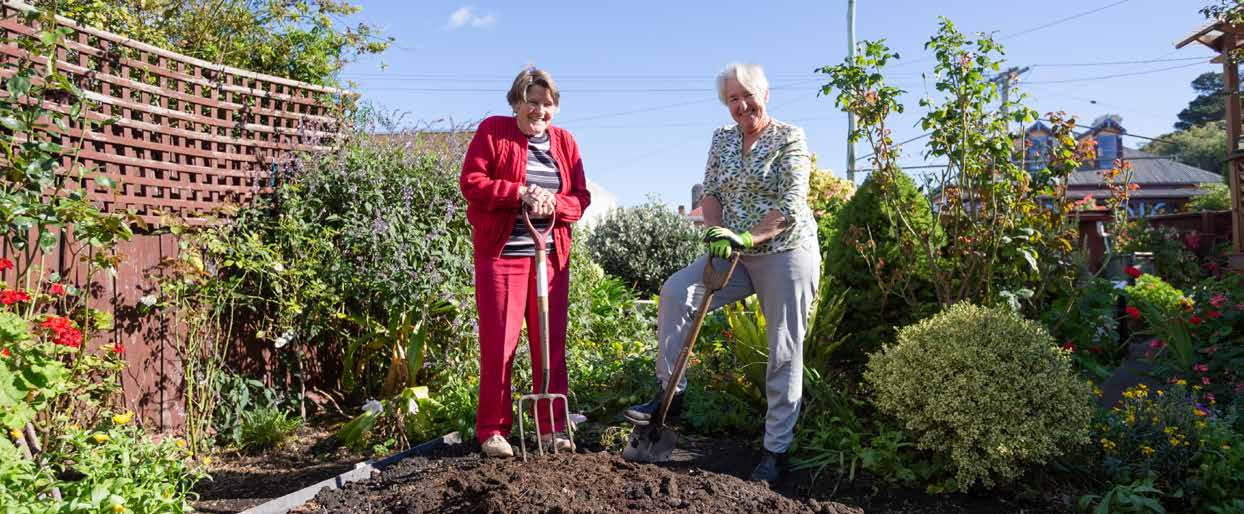
2.3
2.3.1 Enhanced by its human scale, Hobart thrives on connectedness—to each other, our places and spaces, our services and activities. We create opportunities for new connections to develop.
2.3.2 Our connectedness is core to who we are, and we do not lose it as we grow. We invite each other to join in it, recognising that connectedness can be challenging and is not everyone’s way of being.
2.3.3 We are connected to our histories, honouring and learning from our past and keeping future generations at the heart of our thinking.
2.4
2.4.1 We are informed about our community and the services and opportunities that are open to us.
2.4.2 We understand the responsibilities, roles and activities of our local government. We have clear pathways to the services government provides.
2.4.3 We value learning at all ages and stages of life.
2.4.4 Hobart is a city of unique and varied skills and talents, which we foster in everyone, with a focus on children and young people.
2.4.5 We develop the capacity of our human, social and cultural capital, knowledge and networks.
2.4.6 When we see change coming, we are proactive. We respond instead of react.
2.5 WE ARE HEALTHY, JOYFUL AND CONTENT
2.5.1 We have a holistic view of health that involves all aspects of our lives. Mental, physical, emotional, spiritual, cultural and social health are at the core of our decision making.
2.5.2 We support each other to be active and to have lives that are meaningful and fulfilling to us.
2.5.3 Our natural and built spaces and facilities enable activity and support and enhance our health and wellbeing.
2.5.4 We encourage individual and team sports and recreation for a happy and healthy community, recognising that they are also opportunities to see diversity flourish.
2.6 WE KEEP OUR PEOPLE SAFE, HELP EACH OTHER AND FLOURISH IN ADVERSITY
2.6.1 Hobart’s isolation and scale have required resilience. We know that future challenges will demand that we work hard and work together. But we are our best selves in times of adversity and vulnerability. We are caring, helpful and supportive of everyone at all times but especially when things get tough. We flourish in times of hardship.
2.6.2 We are confident and capable when dealing with natural and human-caused threats and emergencies.
2.6.3 We are a safe city, where everyone feels safe and is safe, including in public spaces. We look after each other.
We are a city connected, embracing our diverse communities in cultural expression and creative and artistic participation; a city that enhances our homes, lifestyles and heritage; a city that bravely puts its people first.
3.1.1 Creativity is part of our daily lives—not just in the arts but each of us in our own way.
3.1.2 We challenge ourselves to invent. We are driven by creative thinking. We inspire and are inspired by our city, its people, built environment and ecology.
3.1.3 We use our creativity to make life better. We are fearless and brave, adopting creativity as a fundamental tool in decision-making.
3.2.1 We are home to some of Tasmania’s best-loved cultural institutions. We support them and invite others to enjoy them.
3.2.2 We are a centre for cultural services.
3.2.3 Creative people are attracted to Hobart as a place that brings out the best in us—where we can collaborate and learn from each other, where we can inspire and be inspired.
3.2.4 We are a city that celebrates. We value our events and festivals as sources of learning, entertainment, debate and connections with others.
3.3.1 We create opportunities to explore diversity: ways for people to bring and share their own identities and receive the same in return.
3.3.2 We use arts and events to explore our histories and identities and tell our stories.
3.3.3 Our arts and events raise awareness and increase our understanding and appreciation of one another.
3.3.4 We celebrate Tasmanian Aboriginal culture and creative endeavours, supporting and participating in them as core to this place and community.
3.4
3.4.1 We are a city that supports its writers, visual artists, filmmakers, performers, producers and venues. We support artisans, tinkerers and craftspeople. We encourage and support participation in the arts and creative pursuits, as professionals and amateurs.
3.4.2 Our city is an affordable place for artists and creators to live and work. We protect our creative hubs.
3.4.3 We invest in creativity and culture. We support programs that bring creativity to our city.
3.4.4 We are a wonderful audience for Hobart’s artists and creatives. We support their work and compel them to progress in their careers, to continually inspire and amaze our city and its visitors.
3.4.5 We invite ideas and debate, using our disagreements as a means to foster creativity for better outcomes. Debate propels our city forward.
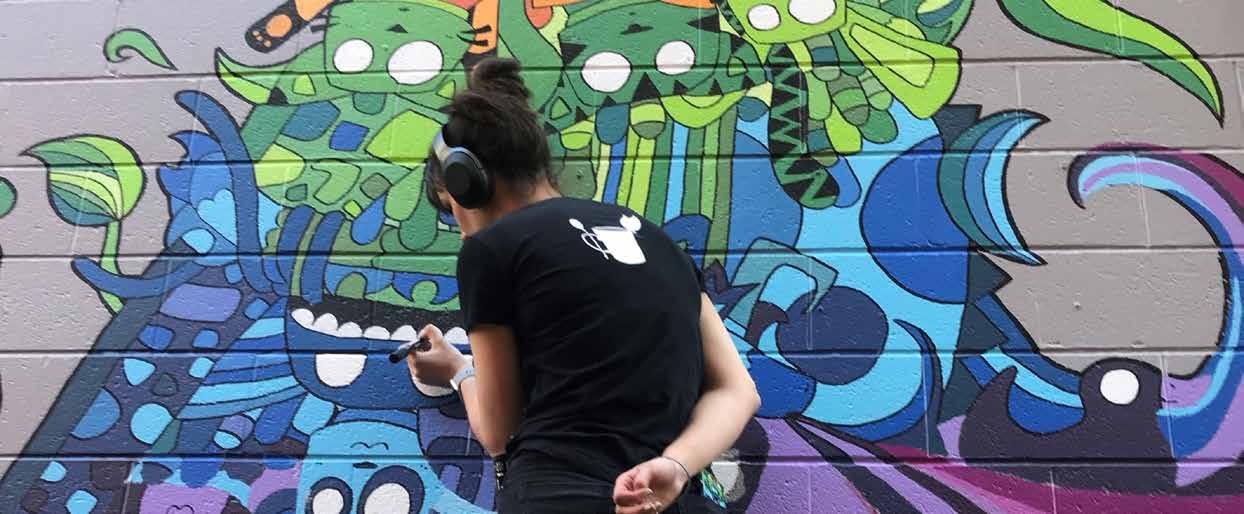
3.5 OUR CIVIC AND HERITAGE SPACES
SUPPORT OUR CREATIVITY
3.5.1 We find creative uses for our civic and heritage spaces, and these spaces support our creativity. Vibrant civic spaces and infrastructure make daily life a creative act. We keep our historic places alive, for the people.
3.5.2 We incorporate culture, recognition of our history and story-telling into our public spaces and significant private developments, inspiring spontaneous and planned creativity and performance.
3.5.3 We use our public and empty spaces to host and fund regular events and activities.
We are a city whose economies connect people, businesses, education and government to create a high-quality lifestyle in a thriving and diverse community. Our city is our workshop. We collaborate, embracing ideas, inventiveness and initiative.
4.1 OUR BUSINESSES AND INDUSTRIES REFLECT AND SUPPORT OUR HOBART IDENTITIES
4.1.1 We are a city of thriving, diverse sectors that foster a culture of welcome and value unique and transferrable skills.
4.1.2 We excel in niche industries and expertise and quality work. We tap into our tendency to be multi-skilled.
4.1.3 We collaborate, supporting each other to succeed. We compete together.
4.1.4 We embrace industries and professions that thrive in Hobart’s unique environment, from Antarctic science and tourism to creative arts and technology.
4.1.5 We value quality over quantity.
4.1.6 We attract investment that supports our businesses and communities to flourish.
4.2.1 We recognise that work and economies are not just about the money. Our concept of value includes time, people, environment and quality of life.
4.2.2 We believe in meaningful work for those who seek it. We have opportunities to develop and express our skills and talents, to make a living in ways that matter.
4.2.3 We acknowledge that not all work is paid work. We value and recognise volunteering and giving back to our communities. We value and recognise the unpaid work that supports the life of our city, including home duties, raising children and caring for others.
4.3.2 Our love of learning stimulates a diverse business ecosystem in Hobart.
4.3.3 We are aware of the skills and talents we need, at local, national and international levels and create ways to contribute.
4.3.4 We enable everyone to participate in the economic life of the city.
4.3.5 We value those who have stayed in Tasmania and developed and applied their skills here, helping to craft our Hobart business culture.
4.3.1 We all follow different paths through working life. We value diverse educational pathways. We prize our educational institutions as both preparing us for work and enriching our lives.
4.3.6 We value pilgrimage—the choice to explore places beyond our island. Those who stay elsewhere take our culture to the world. Those who return bring new ideas and experiences with them, which we can use to enrich and evolve our own thinking.
4.3.7 We embrace those who have moved to Tasmania from elsewhere and work together for better economic outcomes.
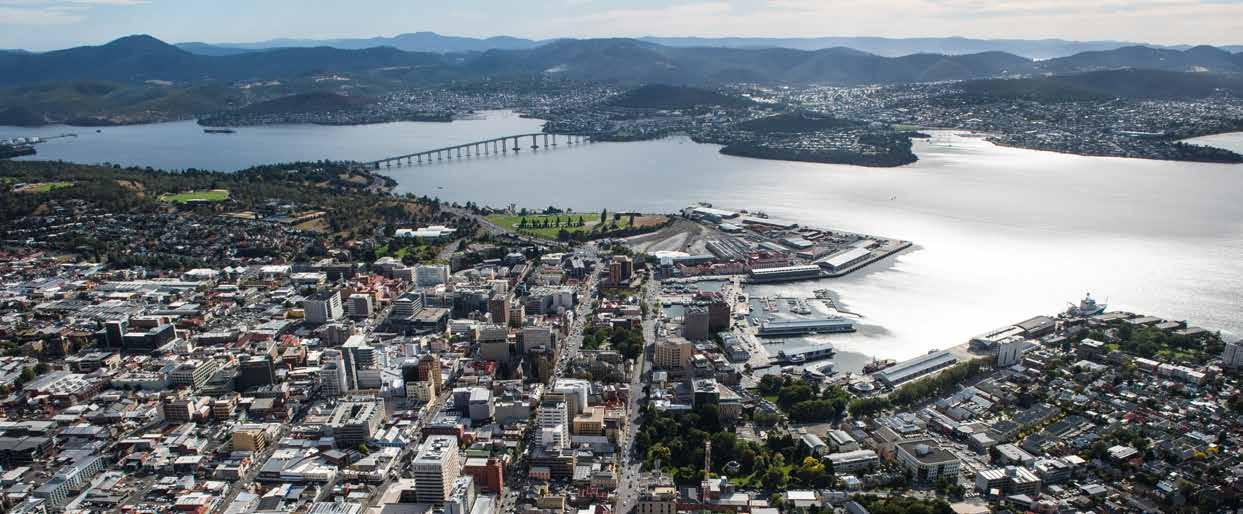
We welcome new people into our culture, quality of life and opportunities for meaningful employment.
4.3.8 We promote Hobart as a perfect environment for remote workers, sole traders, and niche small businesses.
4.4.1 Our connections are one of our biggest assets, and we encourage each other to build strong networks between people, businesses, education and government. We connect industry sectors with jobseekers. We enable clever and resourceful people to find each other and collaborate.
4.4.2 We invite each other into our connections and networks, helping new ideas and perspectives permeate our ways of working. We create openness of opportunity so our city’s people and economies can thrive.
4.4.3 We connect with regions and other cities in
Tasmania. We link people to regional attractions and recognise that we can all share in success—our economies are stronger together.
4.4.4 We attract the right kinds of businesses where people need them, building awareness of the problems business can solve.
4.5 HOBART IS OUR WORKSHOP, SUPPORTING ENTREPRENEURS AND SMALL BUSINESSES
4.5.1 We embrace Hobart’s smallcity scale. The city is our workshop, where we can gather knowledge, create, and test our ideas in an environment that supports and challenges us.
4.5.2 We create opportunities for start-up businesses and entrepreneurs with new ideas.
4.5.3 Our markets are incubators for business, supporting small businesses to scale up, if they want to.
4.5.4 We push each other to excel, with a relentless focus on quality.
4.5.5 Our businesses are able to navigate regulatory and administrative systems to get things done.
4.5.6 We listen to the needs of our business communities.
4.5.7 We support risk taking at the same time that we value what works.
4.6
4.6.1 We learn from our history of relying on single institutions and industries. While we celebrate our successes, we also grow from our failures. Diversity in our industries supports resilience in our economy overall.
4.6.2 We work with and encourage a range of business sizes, in support of a healthy economy that can participate and compete at local, national and international levels.
We are a city where everyone has effective, safe, healthy and environmentally-friendly ways to move and connect, with people, information and goods, and to and through spaces and the natural environment. We are able to maintain a pace of life that allows us to fulfil our needs, such as work, study, business, socialising, recreation, accessing services, shopping, entertainment and spending time with loved ones.
5.1.1 We are proud of the high air quality in our city. Our transport and technology decisions keep our city breathing, protecting and regenerating Hobart’s natural environment.
5.1.2 Any growth or changes to transport and technology must be unobtrusive; natural, environmental and cultural elements are all taken into account whenever we are contemplating any changes to our transportation and technology system.
5.1.3 We make the ecologically sustainable and energy efficient thing the easy thing.
5.1.4 We are bold: we investigate, trial and implement energy efficient transport and technology alternatives for the community.
5.1.5 We seek out and respond to transport and technological opportunities that reduce emissions.
5.2.1 Our slower, less frenetic pace of life continues to be a defining part of our identity. Our transport and technology systems reduce traffic congestion, helping us to spend less time commuting and more time doing what we love.
5.2.2 Connections between spaces are safe and easy to find and navigate. They are interesting, encouraging us to move between them, to be active as we move from place to place and space to space.
5.2.3 Our systems enable the connections between people, nature, history, cultures and our businesses, which make us who we are.
5.3.1 Our cityscape is easy to access and move through, encouraging the movement of people ahead of cars.
5.3.2 Technology and information systems support and enhance transportation options, increasing ease of use, efficiency, sustainability and uptake.
5.3.3 We encourage connectivity to distinctive and diverse businesses, groups and locations by providing transport and technology systems that cater to our long-term needs.
5.3.4 Technology and information systems support, not replace, our face-to-face relationships.
5.4.1 We all have access to a range of travel options that help us meet our daily needs, in particular, systems and infrastructure for public transport, cycling and walking. We all know how to access and use these systems.
5.4.2 Our transport networks provide optimised, easy, seamless and safe connections, through integrated systems that

allow us to make efficient changes between modes.
5.4.3 We are open to investigating, trialling and/or implementing new or reinvigorated transport modes.
5.4.4 Our transport options make our daily activities, such as going to work and school, shopping and socialising, effective and efficient.
5.4.5 People of all abilities have access to effective and efficient transport options.
5.5.1 We use technology to enhance our quality of life.
5.5.2 We take the time to understand community needs when considering technological solutions and approaches.
5.5.3 We make sure no one is left behind as digital communications, engagement and technologies become more prevalent.
5.6.1 We plan for moving and connecting people at the city and wider regional levels. The city is part of a bigger region and we know that working with others, to move and connect people with ease and efficiency, leads to better outcomes for everyone.
5.6.2 We build smart and creative transport and connectivity solutions through long-term collaborations with all levels of government, education, private industry, and wider communities.
5.6.3 We develop appropriate long-term and sustainable solutions by investing in skills, systems and processes in conjunction with the community and a variety of partners.
5.6.4 Information about transport and connectivity projects, progress and outcomes is accessible and available.
We are a city whose people see ourselves as part of a beautiful and unique natural environment, from the mountain to the river, which embrace us and shape our identity. We are proud custodians and advocates, ensuring resources are appreciated rather than wasted, supporting biodiverse ecosystems in honour of past, current and future generations.
6.1 OUR CITY IS A PART OF NATURE AND NATURE IS A PART OF OUR CITY
6.1.1 Hobart is defined by its natural environment and relies on it to exist. We cherish the mountain and the river.
6.1.2 Future generations can see the night sky as we do.
6.1.3 We work to improve the health of the air and water.
6.1.4 We enrich the green areas in our city. We protect our waterfront and waterways and make them pleasant and meaningful places to visit.
6.1.5 Greenways thread through our city. We create and enhance linkages to parks and reserves, and wildlife have corridors relevant to their behaviours and habitats.
6.1.6 We foster opportunities to live our lives locally.
6.1.7 We are able to carry out our daily lives in nature and with access to nature. We do not think of the natural environment as separate or somewhere else but rather as part of our city.
6.2 WE ARE ECOLOGICALLY CONSCIOUS, AWARE AND EMPOWERED
6.2.1 We are educated about the natural environment and important issues. We know Hobart’s plants and animals, its land and marine species—because we can’t value or protect what we don’t know.
6.2.2 We are aware of the impacts of our individual and collective actions.
6.2.3 We feel and are empowered to make good environmental decisions.
6.2.4 We are active and aware in regenerating the ecosystems that have been harmed by human development.
6.3.1 Hobart’s biodiversity is preserved, secure, and flourishing. Protecting and rehabilitating native wildlife, vegetation and other species is central to how we live and work.
6.3.2 Our actions and their byproducts are beneficial to life.
6.3.3 As a gateway to Tasmania, we do our part to maintain our island’s biosecurity.
6.4 WE RESPECT NATURAL RESOURCES AND DESIGN FOR ENERGY EFFICIENCY
6.4.1 We use closed loop energy and waste systems. We respect our access to water, food and energy as critical to life.
6.4.2 Renewable energy systems power our city.
6.4.3 Best practice in energy efficiency is our standard. We ensure buildings and infrastructure lead to the best possible environmental outcomes.
6.4.4 We incentivise ecologically responsible development, including with materials that are responsibly sourced and used.
6.4.5 We make active and public transport easy, planning and building the infrastructure needed to make these modes convenient and effective. We respond
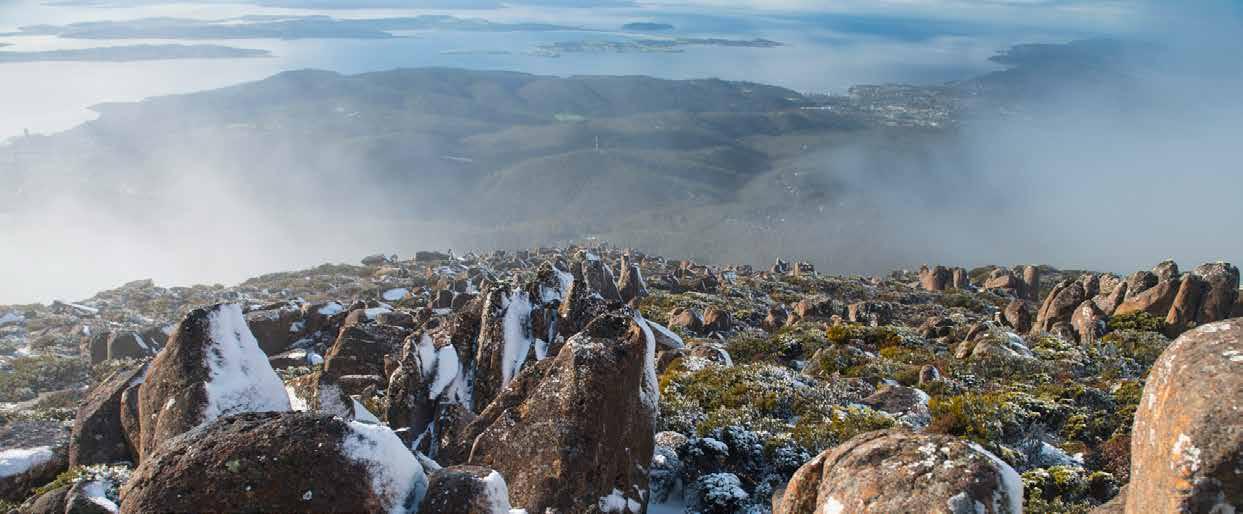
to new opportunities for energy efficient transport and design.
6.5 WE ARE PREPARED FOR AND RESILIENT TO NATURAL DISASTERS
6.5.1 We have designed and maintained our city’s infrastructure so it can handle extreme weather events.
6.5.2 Our city is prepared to prevent and confront bushfires, floods and other natural disasters. We have effective systems in place, where community members are aware of how to protect themselves and their homes and where to go for help.
6.5.3 We mitigate climate change and have adaptation strategies in place.
6.6 WE PARTNER WITH AND LEARN FROM OTHERS
6.6.1 Many of the environmental challenges we face are global challenges. We build on lessons learned in Hobart and elsewhere to
improve our environmental practices and outcomes.
6.6.2 We learn from our communities about important local issues.
6.6.3 We build strong partnerships to protect and regenerate Hobart’s natural environment.
6.7 WE VALUE AND ACCESS NATURAL AREAS FOR SPORT, RECREATION AND PLAY
6.7.1 Our parks, reserves and natural areas continue to support outdoor pursuits such as bushwalking, trail running, mountain biking and rock climbing.
6.7.2 We respect each other and the spaces that we use for sport and recreation, so that all may enjoy them for generations to come.
We are a city that maintains our unique built and ecological character, where we all have a safe, secure and healthy place to live. We are a city where people and communities can access world-class services and infrastructure and provide for their social, cultural and economic wellbeing. We embrace change but not at the expense of our Hobart identity and character.
7.1.1 Our city is our home, and we all have access to a place to live, no matter our life stage or situation.
7.1.2 We support diversity in our housing supply, acknowledging that different housing types suit different people.
7.1.3 We recognise that not all of us want or need to buy a home and ensure a supply of rental properties.
7.1.4 Housing is affordable, and none of us experiences housing stress.
7.1.5 We have housing available for those of us experiencing disadvantage. We cater for vulnerability. Social housing is part of, not separate from, the communities, services and access that are everyone’s right.
7.2
7.2.1 One of our favourite benefits of Hobart is the simple joys of daily life. Our housing and built environment supports our sense of community. We have social, economic and cultural diversity within our suburbs.
7.2.2 We diversify our land usage so that our neighbourhoods cater for residential, commercial and other aspects of life. We design for how the city will actually be used, at human scale.
7.2.3 We take advantage of what we have, working with existing housing and buildings to adapt to changing needs and environments, maintaining Hobart’s aesthetic and character.
7.2.4 We maintain and enhance the quality of the natural environment as our housing and other development evolve. We foster considered design to sustain our clean environment and the human scale of our city.
7.2.5 Public spaces are included in developments, in support of our human needs and wellbeing and the cohesion of our city.
7.2.6 Hobart’s landscape is one of our greatest loves and our greatest challenges— the surrounding hills and water limit where and how we can build. As we move into the future, we balance population growth with the density and scale of our city.
7.2.7 We encourage housing and development that are consistent with our values of space, heritage, access to sunshine, views of nature and human scale. Our built environment reflects and enhances the history, heritage and cultures that make up our identity.
7.2.8 We foster excellence in urban design practice and protocol, ensuring that the character of our built environment reflects the intent of the vision statement and all other pillars and identity statements.
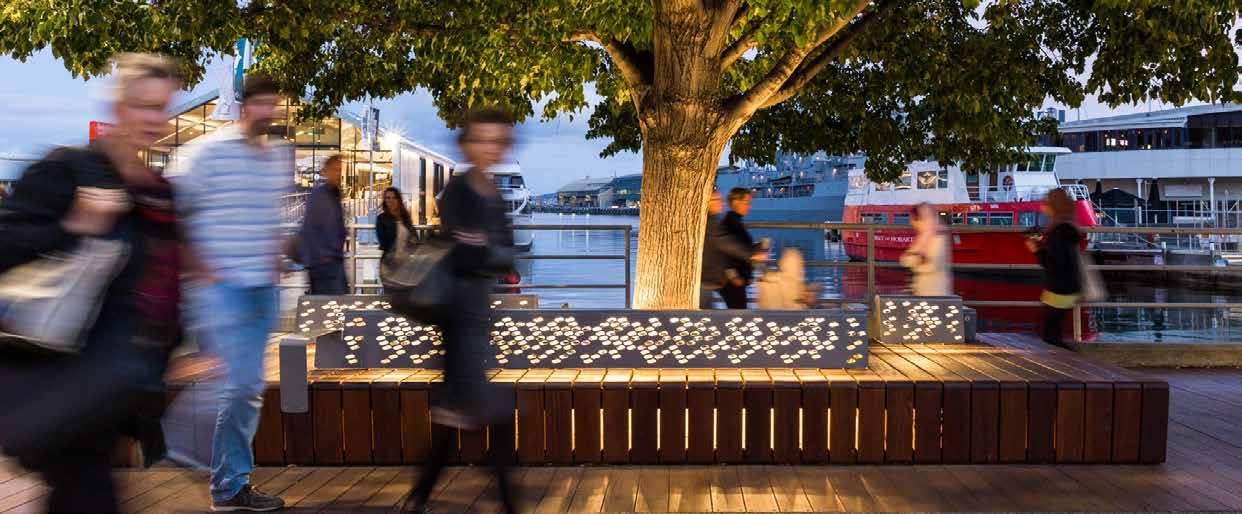
7.3 INFRASTRUCTURE AND SERVICES SUPPORT A HIGH QUALITY OF LIFE
7.3.1 We have world-class infrastructure that supports affordable living and access to work, study, services and other facets of life.
7.3.2 Our infrastructure, services and other aspects of our built environment support equal access for all.
7.3.3 Our infrastructure and services are planned, managed and maintained so they provide longterm benefits to Hobart communities.
7.4 WE BALANCE LOCAL NEEDS WITH THOSE OF VISITORS AND INVESTORS
7.4.1 We invite visitors and tourists to enjoy our city and recognise their important contributions to city life.
7.4.2 We manage visitor accommodation so that it does not negatively affect or infringe on the availability of longer-term housing or reduce neighbourhood safety or cohesion.
7.4.3 We support investors to understand the communities they are buying into. The value of housing as investment does not override the value of housing as a place to live.
7.5 WE UNDERSTAND AND ENGAGE ON HOW PLANNING ISSUES AFFECT OUR CITY
7.5.1 We cooperate, collaborate and foster active communication between stakeholders.
7.5.2 We work together across regions, communities, the private sector and all levels of government toward long-term planning and infrastructure outcomes.
7.5.3 Strong community leaders help represent our interests, transparently and ethically.
7.5.4 Information about major developments is available and accessible. Their longer-term impacts are considered and residents have the chance to engage.
7.5.5 We balance our personal desires for our neighbourhoods and city with the needs of our city as a whole.
7.6 WE ARE DELIBERATE IN OUR DEVELOPMENT AND PLAN FOR THE FUTURE
7.6.1 We acknowledge that it is important to plan for future generations but also that we are all going through change now, as we move through different stages in life. Planning, infrastructure and development take part in facilitating the changing needs of people and communities.
7.6.2 We anticipate future need in conjunction with experts.
7.6.3 We guide and respond to projected population growth and change.
7.6.4 Our communities have the opportunity to access information on important trends and influences that could affect our urban fabric.
7.6.5 Our city evolves but we approach development deliberately and with patience and respect. We understand that true and meaningful growth and progress take time.
We are a city of ethics and integrity. We govern with transparency and accountability, encouraging and welcoming active civic involvement. We collaborate for the collective good, working together to create a successful Hobart.
8.1 WE ARE STRONG IN OUR ETHICS
8.1.1 We act with authenticity and integrity. We are transparent, accountable and responsible to each other. We are trusting and trustworthy. We reflect on and evaluate our performance. And we expect this of our government.
8.1.2 Our communities are confident in the governance of our city.
8.2 WE BUILD AND MAINTAIN STRONG PARTNERSHIPS
8.2.1 We work with each other to understand communities’ needs and achieve great outcomes for Hobart. We have coherent relationships, where we each understand what to expect and what is expected of us.
8.2.2 We seek advocates who encourage the civic involvement of their communities.
8.2.3 We use our connections and networks to enable participation in civic life. Our strong partnerships
support collaboration across councils, community organisations, businesses and other levels of government.
8.3.1 We know the people who govern and influence our city. We have access to decision makers and have opportunities to engage in the governance of our cities.
8.3.2 We ourselves are empowered to influence what happens in the place we call home.
8.3.3 As decision makers, we actively seek input from our city, acknowledging that we are all experts in the day-today experience of living in Hobart.
8.4.1 We have diverse leadership representing our diverse communities.
8.4.2 Our leadership is willing to take risks and is open to new ideas. Our people are
creative, inventive, honest and resilient, and our government and community decision makers are too. We recognise these qualities are a means to an end: it is up to us to decide what we are trying to achieve.
8.4.3 We deliver on the intent of our vision, identity statements and pillars.
8.5.1 We empower community members to have their say. Our governance structures demonstrate listening and acting on public suggestions.
8.5.2 Our government knows our people and how to engage, adapting communication styles to suit various stakeholders and generate greater understanding.
8.5.3 Engagement with our communities is proactive and inclusive, so we know about and can participate in decisions and outcomes that affect us.
8.5.4 Our local government is accountable to our communities, acting as an
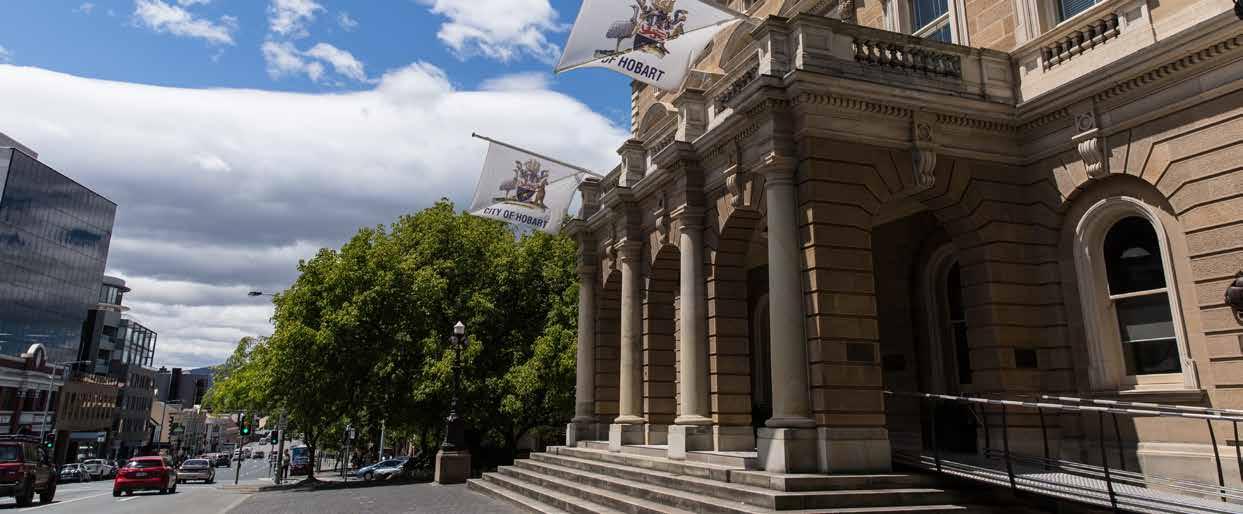
exemplar council in working with and inspiring people from across the city to contribute.
8.6 WE ARE INVOLVED IN CIVIC
8.6.1 We do not take our democracy for granted.
8.6.2 We participate in decision making and hold our leaders and each other to account.
8.6.3 Our leaders embrace and act on their responsibility to the people.
8.6.4 We maintain open dialogue and recognise each of us as stakeholders and participants in our city life.
8.6.5 We feel ownership of and responsibility for our city, our neighbourhoods and our communities.
A community panel is one form of deliberative democracy, a community engagement method involving bringing together a group of community members to discuss a topic of importance, in this case, the vision for their city. They receive and consider information about the topic and offer recommendations to decision makers. The Vision Project Community Panel deliberated on findings from preceding stages of engagement and offered a draft vision framework as their recommendation to Council.
Focus areas are the more specific concepts listed under each pillar (for example, focus area 7.1: We all have access to an affordable home). Each focus area contains additional points that explain more about what it means.
In this document, the term ‘government’ by itself refers to all levels and types of government that are applicable to Hobart. For example, Identity Statement 7: How we engagement in civic life and Pillar 8: Governance and civic involvement, refer to government generally, as opposed to local government only. This is because Hobart community members have values and expectations about government that apply to all levels of government, not just local.
The term ‘Tasmanian Government’ refers to the state government of Tasmania; the term ‘Australian Government’ refers to the federal government of Australia.
The muwinina or mouherneena people of the South East Tribe were the traditional owners and custodians of the land where greater Hobart is now located.
Sense of place describes people’s relationship with places, expressed through various parts of human life, such as emotions, stories and personal experiences. Sense of place may also have to with place attachment, human bonds with a particular place, and place meaning, the symbolic meaning that people give to it. Sense of place evolves through culture, history, environment, economics, politics, geography, and other aspects of the interactions between humans and built and natural environments.
Spirit of place and sense of place are often used interchangeably but they have slightly different meanings. Spirit of place has its origins in Greek and Roman mythologies, describing a guardian deity of a particular place. In modern times, spirit of place refers to the unique, distinctive, essential and cherished aspects of a place. It is about what makes a place special, especially in terms of intangible qualities that can be difficult to describe.
The strategic plan is a 10-year plan required of all Tasmanian local governments under the Local Government Act 1993. It outlines what a given council plans to achieve during a 10year period. Annual plans and annual reports describe shorter-term goals and progress.
